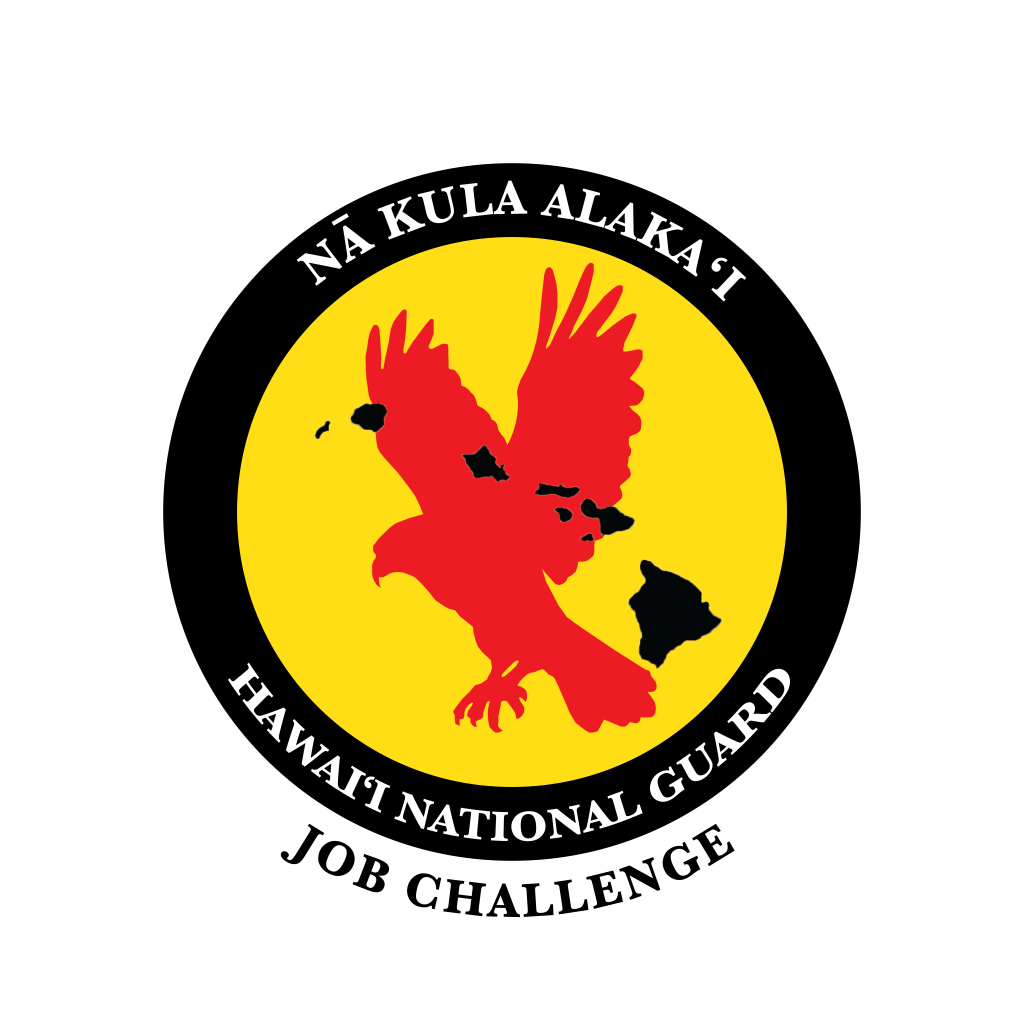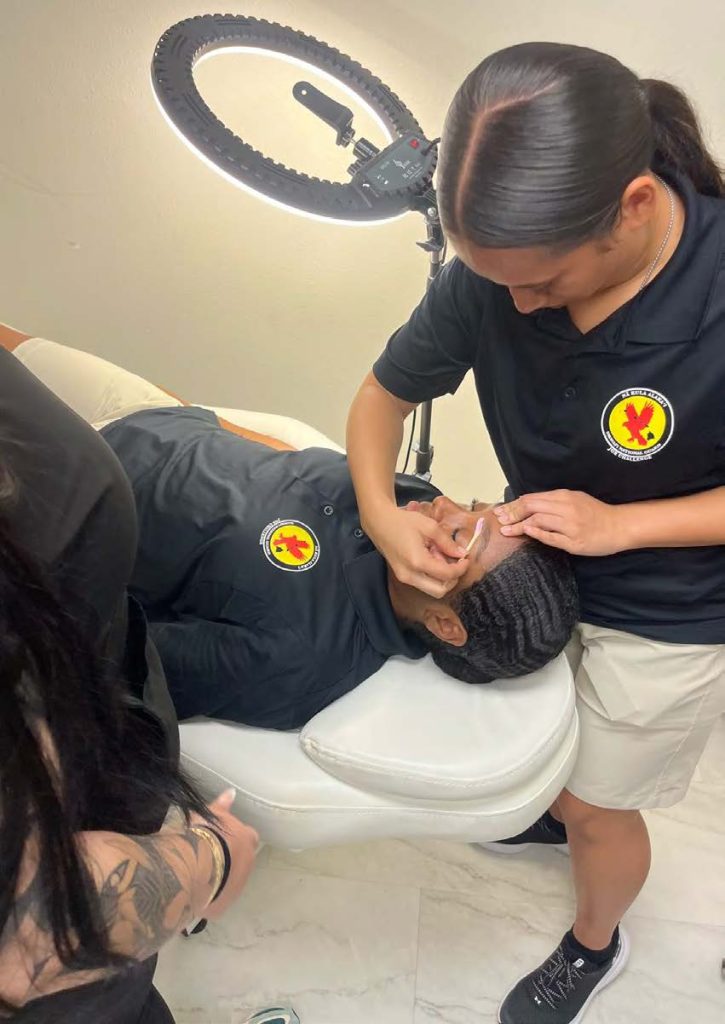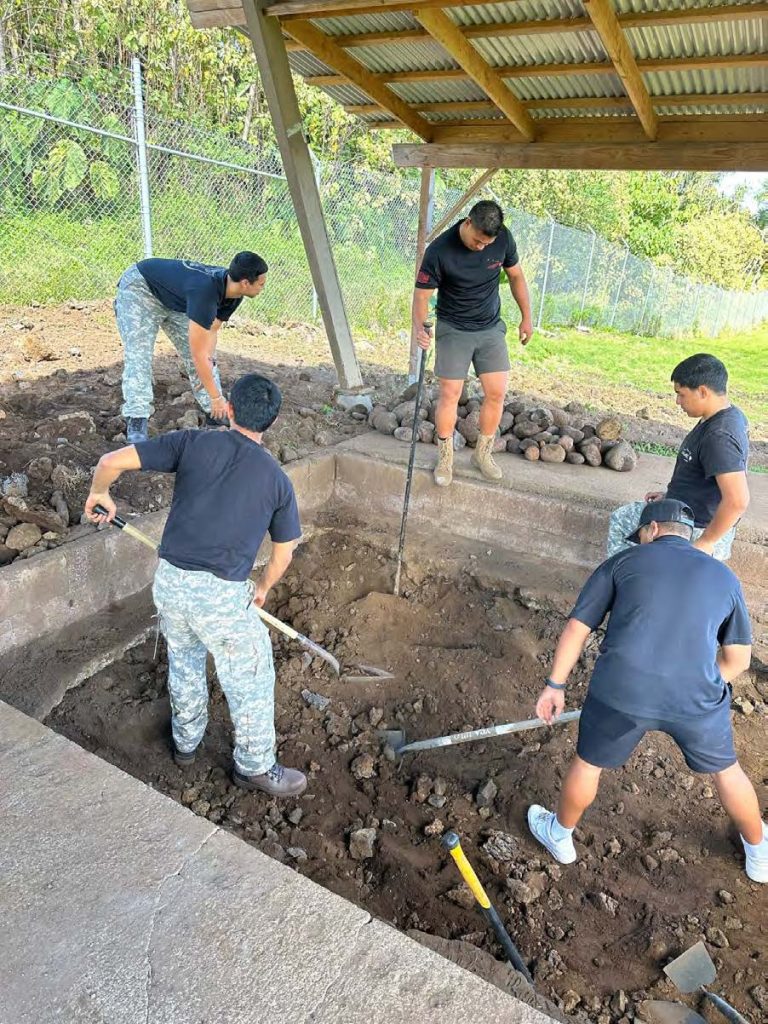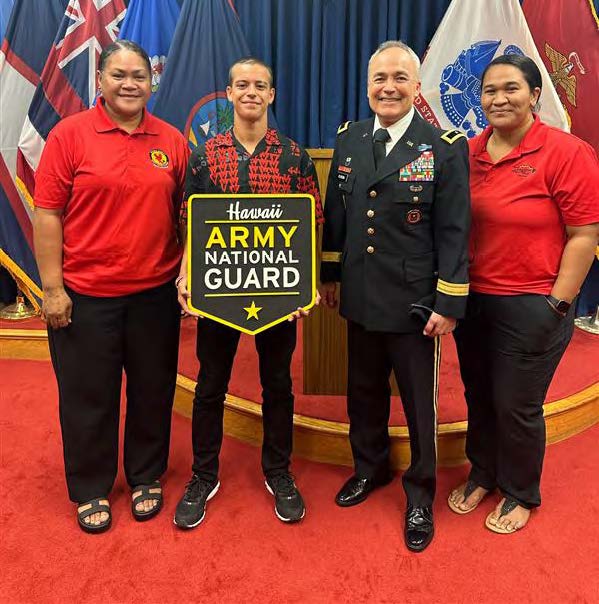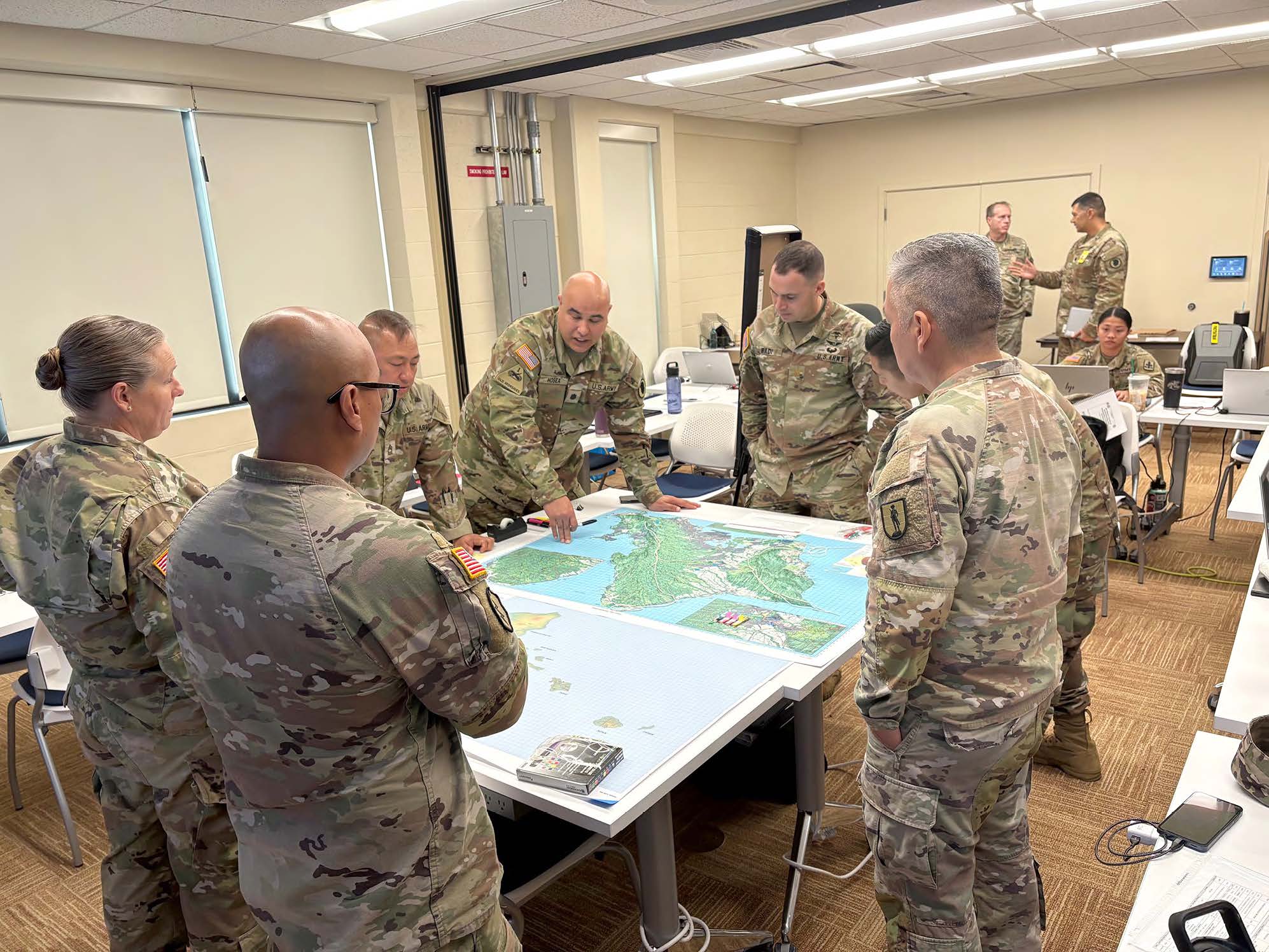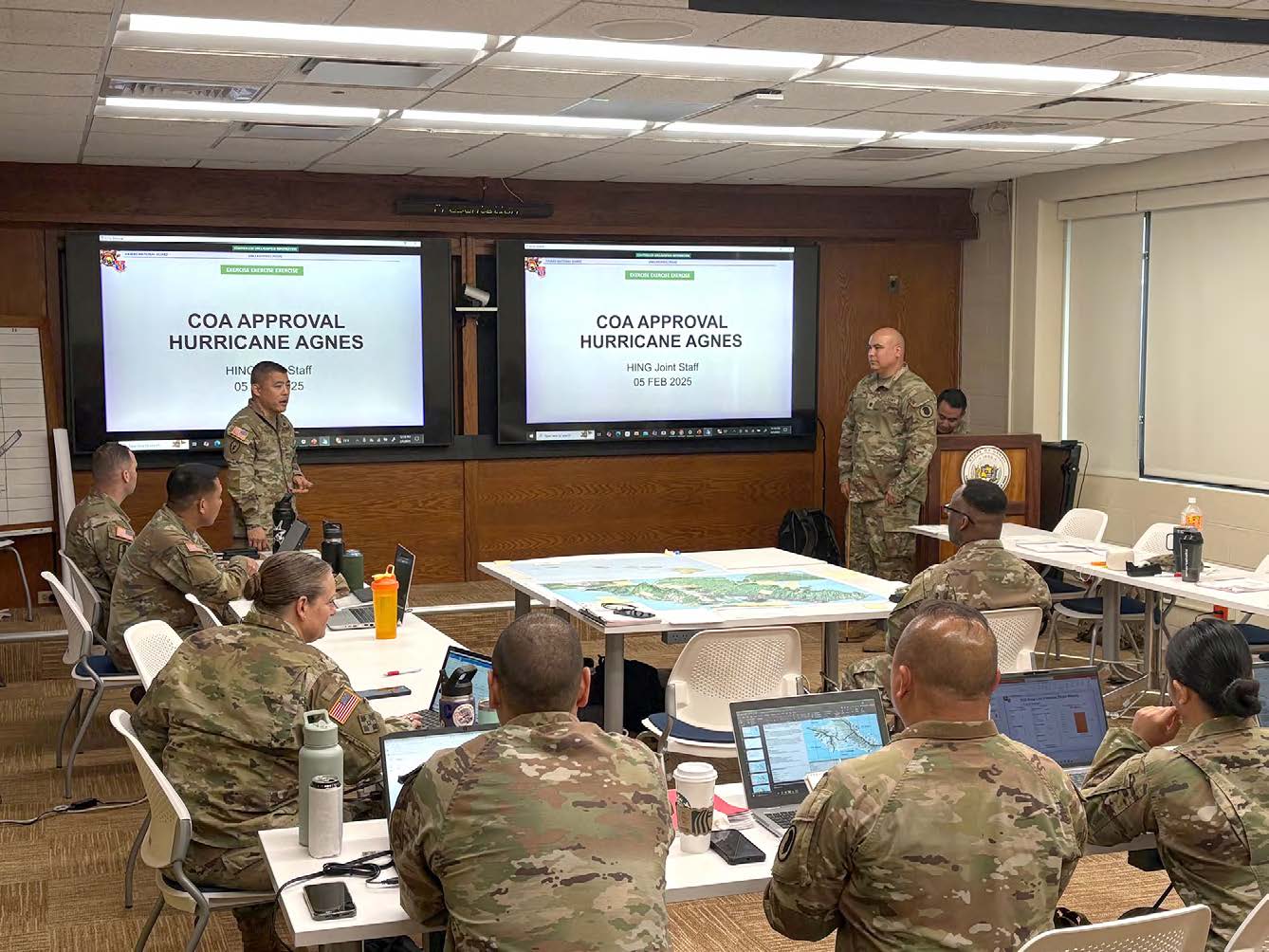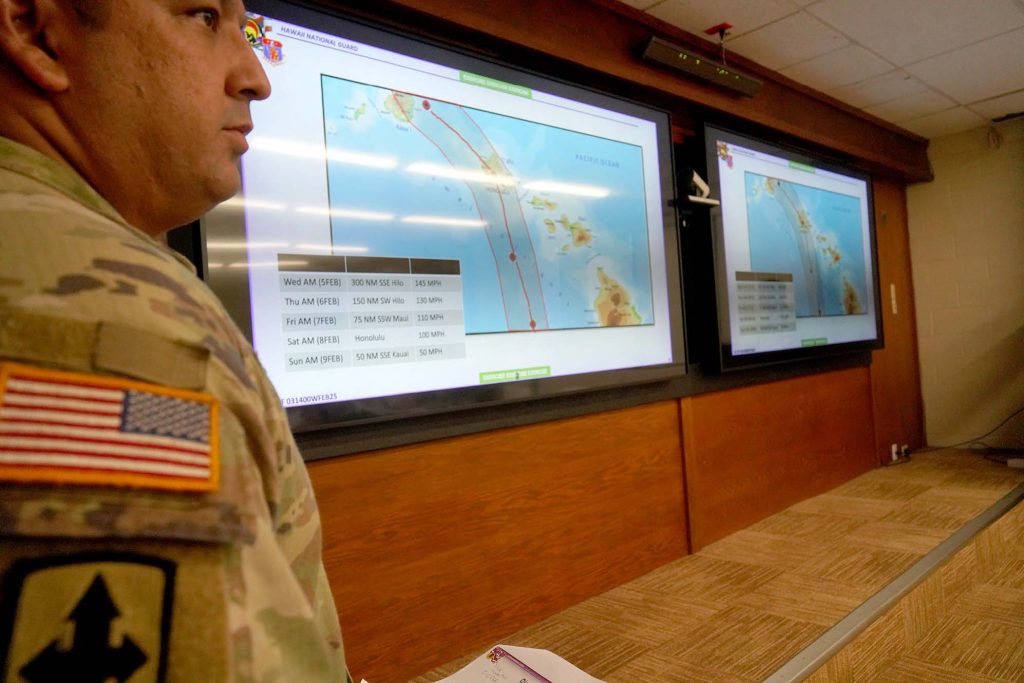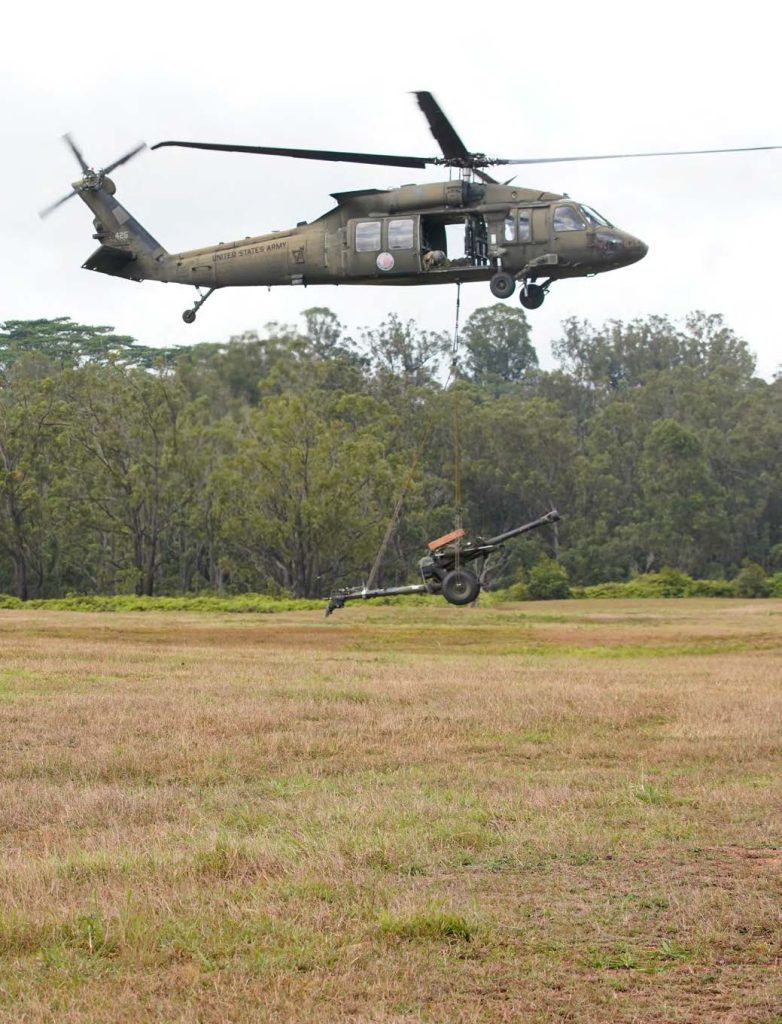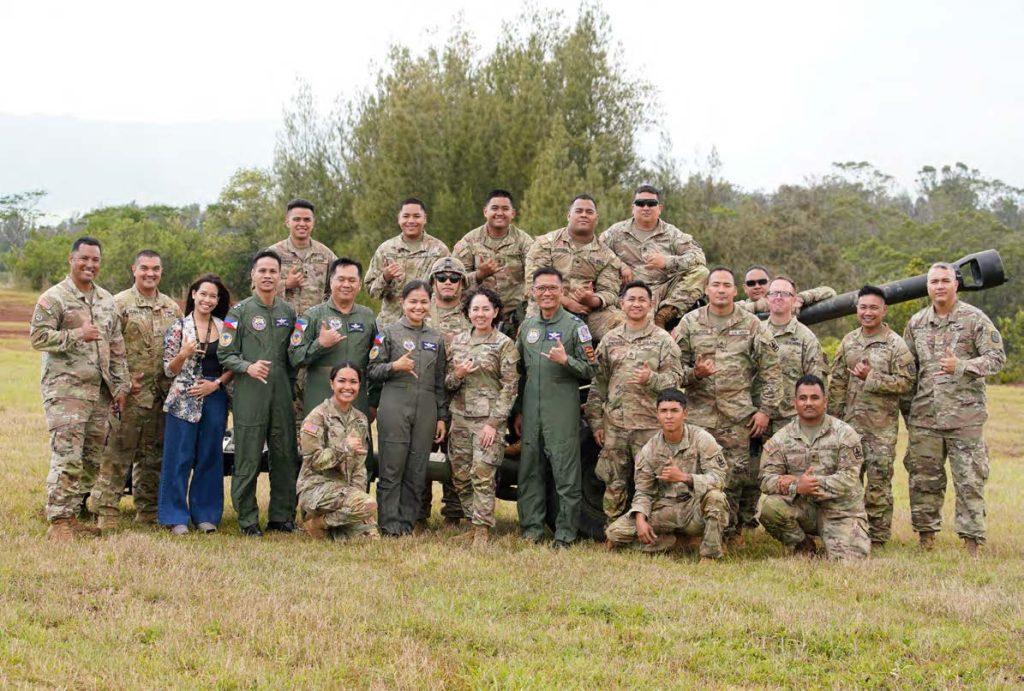STATE OF HAWAI‘I DEPARTMENT OF DEFENSE
2025 Reader Survey Results
To the readers of the HIDOD newsletter, pūpūkahi, thank you.
We asked readers to take a survey about the pūpūkahi and share with us what they like about it, how often they read it, what we can do to improve and more. We received over 100 responses and you did not disappoint. We were provided with tons of comments, ideas, improvements and criticisms. A definite direction was laid for us to follow. We will be doing another survey in about a year to measure the changes and hopefully success.
We are in the process of redesigning the pūpūkahi for our next issue published in June of this year. There will be new colors, graphics representing HIDOD divisions, fonts, sections and a fresh look. We will improve what we cover and how we cover it. You have spoken. The ideas received via the survey will be incorporated into our new plan for the pūpūkahi.
We wanted to share the results of our survey with you so you can see where your answers and suggestions may have landed with other readers.
Current facts about the pupukahi:
- The current design is about 10 years old
- The pūpūkahi is 50 years old
- Currently we are publishing quarterly
- We publish online; a PDF is placed on our HIDOD website
- The pūpūkahi used to be printed and mailed out to subscribers, units and employees. The cost of printing and mailing became very high, which led us to changing the distributing to digital only in 2009.
- We currently have 120 subscribers of the pūpūkahi.
Question 1: Are you a…?
Most were current HING members, then former HING members. Not a lot of HIDOD current or former employees read our department-wide newsletter.

What are we, the Public Affairs Office, going to do about this?
We need to do a better job of sharing with HIDOD employees that the pūpūkahi exists. We need content that will matter to them and that they will find informative and interesting. There are about 500 state employees, but only had six responded to this survey. We have a lot of work to do on this. There are also about 5,500 HING members, with only 50 current members completing this survey. We need to improve within the HING and with our HING retirees.
Question 2: How often would you like to read the pūpūkahi?

A slight majority chose quarterly, which is what we are currently doing. The next two answers though want an issue more regularly, 35 want it monthly or bimonthly. And finally, another 10 just want it. Eight survey takers have never read an issue.
What are we, the Public Affairs Office, going to do about this?
We are not able to publish an issue weekly or monthly with our current staffing and responsibilities. However, we know that people are happy with the current frequency, but more would more satisfied if it were monthly or bi-monthly. So, we are going to be publishing the new version of the pūpūkahi every two months or bimonthly. Every other month we will try to inform the employees of the State of Hawaii Department of Defense.
Question 3: How do you read it?
About half use a computer and a fourth use their phones. And on this question, twelve people who took the survey don’t even read the pūpūkahi.

What are we, the Public Affairs Office, going to do about this?
With a majority using a computer, we will continue to offer the latest versions on-line in a friendly PDF format. You can view it on our page or download it. For phones, we will be making an improvement. Based on some suggestions, we will make it more mobile friendly. That means a little more work for us to get it formatted, but we are guessing that our number in that category will go up after we start producing the mobile-friendly version. Tablet users will not be affected.
Question 4: What age range are you?

Our largest age range is that group, 55-64, that remember the “heyday” of the pūpūkahi when it was printed and the question was always asked when taking a pic at an event, “Is this going in the pūpūkahi?” The rest of the age groups were only separated by a few. It was nice to see some 18-24 year olds who took the survey.
What are we, the Public Affairs Office, going to do about this?
We will continue to keep our retirees informed using the pūpūkahi and Retiree News and as well as have articles and topics that would interest 18-34 year olds. We need to keep all age ranges in mind when planning content. It was a very good mix of age groups and that was not expected. We thought we would skew older/wiser.
Question 5: How do you receive the pūpūkahi?
The vast majority get it via subscribing from our website. We need to improve this option and let more people know about it. The next highest answer was from unit emails, which is a good sign.

What are we, the Public Affairs Office, going to do about this?
We are going to launch an awareness campaign on how to subscribe to the pūpūkahi online. It can be done via phone, laptop or tablet. We will advertise on our social media platforms- Facebook, Instagram, X/Twitter, and LinkedIn about how to subscribe. We may even do a podcast on the pūpūkahi and ask for subscriptions from our listeners. We will also do a push to our division leadership (HIARNG, HIANG, HI-EMA, Office of Veterans’ Services and Civilian Military Programs) who can get the word out to the majority of the HIDOD members. Heck, if you call our office, we will sign you up (808-441-7000).
Question 6: Are you subscribed?

Over half of the people surveyed are current subscribers. Thirty-eight people who took the survey are not. This is one area where we need to double or triple our numbers. If you would like to subscribe to the pūpūkahi
What are we, the Public Affairs Office, going to do about this?
An aggressive awareness campaign to get readers to subscribe.
Question 7: Is the pūpūkahi helpful?
Not everyone surveyed answered this question. It may have been worded a little vague. Forty-three found the pūpūkahi helpful.

What are we, the Public Affairs Office, going to do about this?
We are going to track more intently the content that goes into the pūpūkahi. We will not just list accomplishments, but share resources, and best practices and maybe some opportunities for readers to take advantage of. We are always open to hearing from our readers, so we will make a feedback option more available. Since we will be publishing bi-monthly, we can use more story ideas, hearing about amazing people and sharing history that that will entertain and educate.
Question 8: What do you like about it (the pūpūkahi)?
Many of the answers focused on reading about things that occurred in the organization. They liked being “kept up to date” and “what’s happening”. Specifically, about what members are doing, promotions, changes of command, retirements, new equipment, training, exercises and new hires. They like the many pictures that are posted and info about specific units. Many retirees mentioned that they liked following their old units and former peers.
What are we, the Public Affairs Office, going to do about this?
One person mentioned that it was “Air” heavy; there’s a good reason for that – the 154th Wing has a full time public affairs section, the HIARNG does not. The Wing PA Team puts out great content and we publish it. The 117th Mobile Public Affairs on the HIARNG side, is a drill-status unit (DSG for the Air Folk) and we get their stories when they have drill or participate in larger events. We as a State PA Office will try to even that out. We will also feature the other three divisions of the HIDOD- OVS, HI-EMA and Civ-Mil Programs.
For specific units in the Guard and offices in the divisions, we will ask leaders to provide updates about what is going on in their sections. This will provide very specific updates, and the content will be created by the unit or section.
We will also keep up the number of fantastic photos that our photojournalists continue to churn out.
We will attempt to keep our audience informed and up to date. We will track what units or divisions we cover in issues, then make sure we add some new ones for the next version, and so on. We will attempt to cover every major unit and all divisions at minimum, once a year.
We would love to get feedback throughout the year that can help us diversify our content and what we cover. We do ask that you give us enough time to plan for that coverage. We also accept submissions of stories and pictures- we can help edit stories.
Question 8: What don’t you like about it (the pūpūkahi)?
A big one was: more news about junior ranked Soldiers and Airmen, too much emphasis on the leaders.
Some did not like the name “pupukahi” and thought that it hurts us. The lack of recognition and those unfamiliar with the Hawaiian language. Some felt that it hurts the “branding” level as well. Pūpūkahi means harmoniously united, as in harmonious co-operation, forward, companions, unite to obtain progress and good fortune (according to Wehewehe.org: Ka Haka ʻUla O Keʻelikōlani College of Hawaiian Language University of Hawaiʻi at Hilo). It is part of a collection of words that have gained in popularity over the last few decades along with words that mean loyalty, responsibility, humbleness, respect, trust and a strong effort.
Some just flat out said that they don’t see the newsletter and it is not consistently sent out by units.
There was also the mention about not knowing about the subscriber option.
They also mentioned that the font is too small, and it was difficult to read on a phone.
What are we, the Public Affairs Office, going to do about this?
We are keeping the name pūpūkahi, to keep us united with our past. On our next issue, which will have the redesign, we have “State of Hawaii Department of Defense” on the title logo along with the definition of pūpūkahi. We will, however, work on a campaign to educate HIDOD employees (including HING members) what the pūpūkahi is and also how to subscribe to it.
We are also increasing the font size and making it much easier to read with a phone. This will occur for our June issue. The new design will also include colors and infographics for our divisions, and new sections of the newsletter that will feature different topics. We will also be releasing a Digital version and PDF simultaneously to aid with readability on mobile devises
Question 9: Do you have any suggestions? And what we are doing about them.
Many of the suggestions have been topics already covered: how to subscribe easier, more news about individual state workers, Soldiers or Airmen, how to get a copy of the newsletter, and increasing special sections- tips, facts, history, alumni corner, news sections, how to volunteer…
One suggestion was to add more resources for veterans and retirees. Hiki no! Can do.
We know that this was from a veteran: “bring back cartoons”. We will need to look into this one. If you know of an artist (with a great sense of humor), please send them our way!
Someone suggested holding contests – writing and photography. That is a great idea! Along with guests columnist and Op-Eds.
When we feature units, we also discuss new leadership, mission, new facilities and new equipment that is being used.
An idea to increase awareness was to have a “road show” during drill weekends, so they can see how relevant the pūpūkahi can be. Another great idea!!!
Someone mentioned a different newsletter for retirees – Yes, it is called Retiree News, and before he left command, Maj. Gen. Kenneth Hara, had us start it up. We took it over from Lt. Col. (Ret) Galen Yoshimoto, HIANG, and publish it on our website: https://dod.hawaii.gov/retireenews/. It is targeted to retirees and takes submission ideas which you can subscribe to.
Another idea was to feature some of the old leaders or department heads and list what they are up to. We will definitely do that. We may also use another format to feature those – our podcasts. You can check them out on Spotify, Apple and YouTube under the name “Na Koa Exchange: Boots, Wings and More.” We will be bringing in former leaders and HIDOD members and “talk story.”
Thank you all for your submissions and participation in the survey. The information you provided helped us develop, refine, update and design a better pūpūkahi moving forward. Please keep an eye out for all of the changes that will be implemented in our new design coming out in our June issue and every other month after that!
Mahalo,
The State Public Affairs Office Team
HAWAI‘I NATIONAL GUARD
Adjutant General Confirmed by the Hawaiʻi State Senate
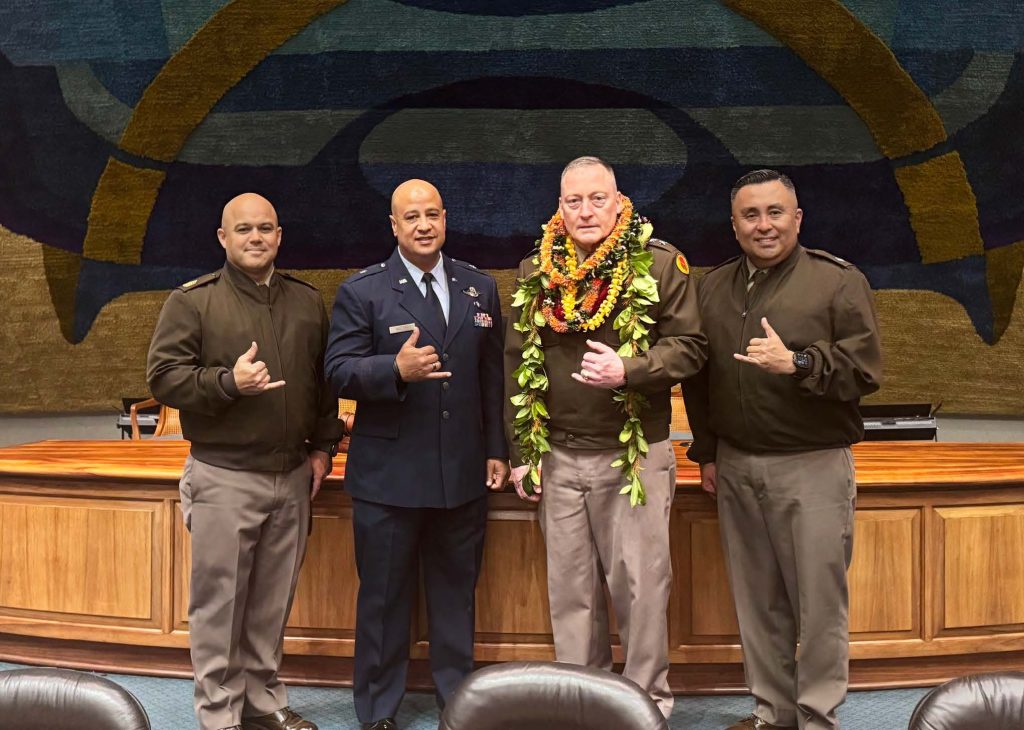
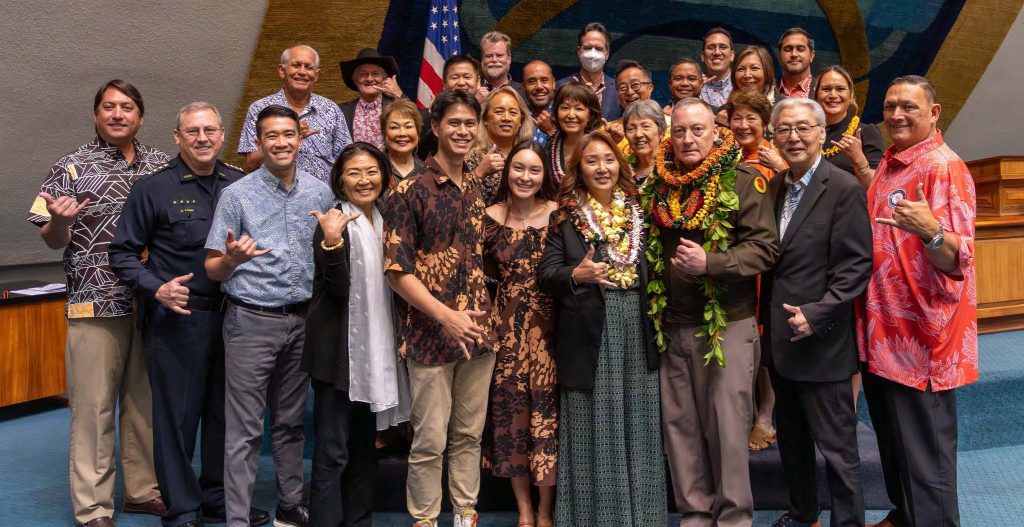

Maj. Gen. Stephen F. Logan was confirmed by the Hawaiʻi State Senate on March 21, 2025 as the Adjutant General for the State of Hawai‘i Department of Defense. “My commitment is to serve Hawai‘i with integrity, dedication, and a focus on enhancing our state’s defense capabilities. I look forward to working alongside our military and community partners to ensure the safety and security of our state and its residents,” Logan said.
HAWAI‘I NATIONAL GUARD
Hawai‘i National Guardsmen Remembered for Displaying Extraordinary Heroism
National Medal of Honor Day is celebrated annually on March 25th to honor the heroism and sacrifice of Medal of Honor recipients. – State of Hawai‘i, Department of Defense Public Affairs Office | Story by Rachel Blaire | Tuesday, March 25, 2025
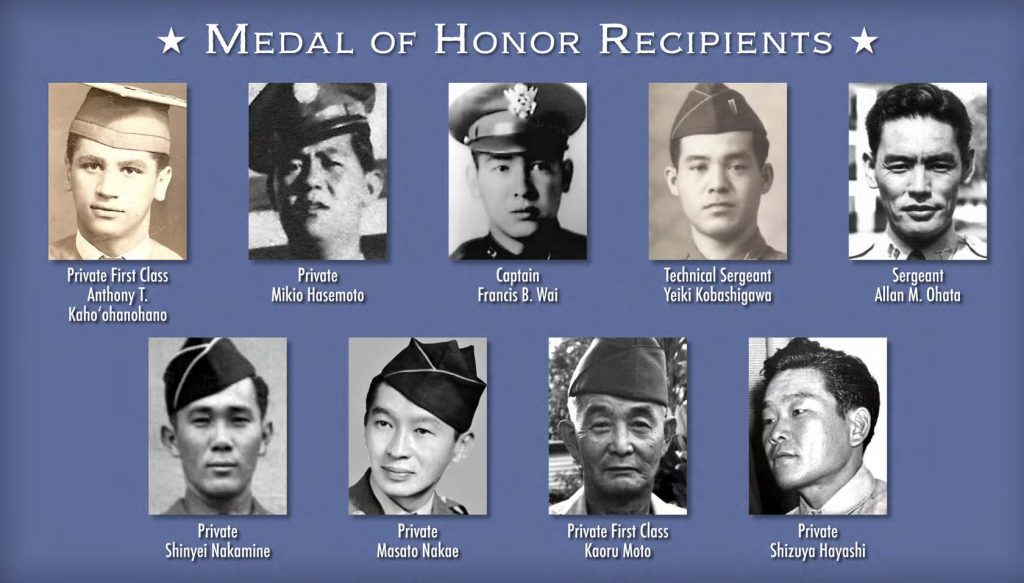

The Medal of Honor is the highest U.S. military award for valor in combat. Over 3,400 Medals of Honor have been awarded to members of the Armed Forces and the Coast Guard. The medal is given only for exceptional bravery, supported by thorough documentation.
Nine Hawaii Guardsmen have been awarded the Medal of Honor throughout the history of the Hawaii National Guard.
These men, were originally awarded the Distinguished Service Cross, had their awards upgraded to the Medal of Honor due to their extraordinary actions during World War II and the Korean War. Eight of the men were recognized for their bravery in World War II and were awarded the Medal of Honor in 2000. Another Hawaii Guardsman received his in April 2011 for his actions during the Korean War.
The nine men are: Pvt. Mikio Hasemoto, Pvt. Shizuya Hayashi, Tech. Sgt. Yeiki Kobashigawa, Pfc. Kaoru Moto, Pfc. Anthony T. Kaho’ohanohano, Pvt. Masato Nakae, Pvt. Shinyei Nakamine, Sgt. Allan Ohata, and Capt. Francis Wai.
Korean War
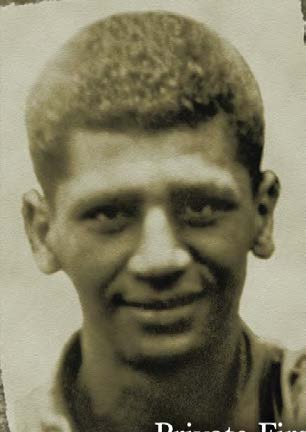
Private First Class Anthony Kaho’ohanohano
Private First Class Anthony Kaho’ohanohano, born on July 22, 1930, in Maui, Hawaii, joined the Hawaii National Guard after high school, following in the footsteps of his military family. On Feb. 5, 1951, he joined the regular Army and was assigned to Company H, 17th Infantry Regiment, 7th Infantry Division.
On 1 September 1951 during an enemy attack in Korea, Kaho’ohanohano displayed extraordinary heroism. He provided covering fire for his unit’s withdrawal, then returned to his position to fight alone despite being wounded. When his ammunition ran out, he
fought hand-to-hand until he was killed. Eleven enemy soldiers were killed, including two in close combat and his actions inspired a counterattack that repelled the enemy.
Kaho’ohanohano’s legacy lives on in Hawaii, where a National Guard armory is named in his honor.
World War II
Private Mikio Hasemoto
Private Mikio Hasemoto, a second-generation Japanese American was born in Honolulu, Hawaii, in 1916. Just months before the U.S. entered the war in June 1941, Hasemoto joined the Hawaii National guard as a 298th Infantry Soldier assigned to the Hawaiian Provisional Infantry Battalion. In 1942, he volunteered for the 100th Infantry Battalion, a newly formed unit composed of Japanese Americans.
Hasemoto displayed extraordinary heroism on 29 November 1943 in Cerasuolo, Italy, when he fought off an enemy attack. Despite his rifle being damaged, he repeatedly ran through enemy fire to retrieve new weapons and continue fighting. With his squad leader, he killed 20 enemy soldiers and captured one. Hasemoto continued to repel attacks until he was killed the next day.
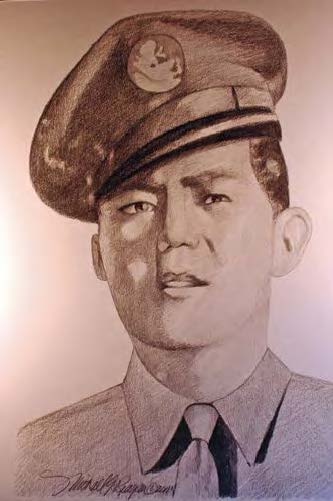
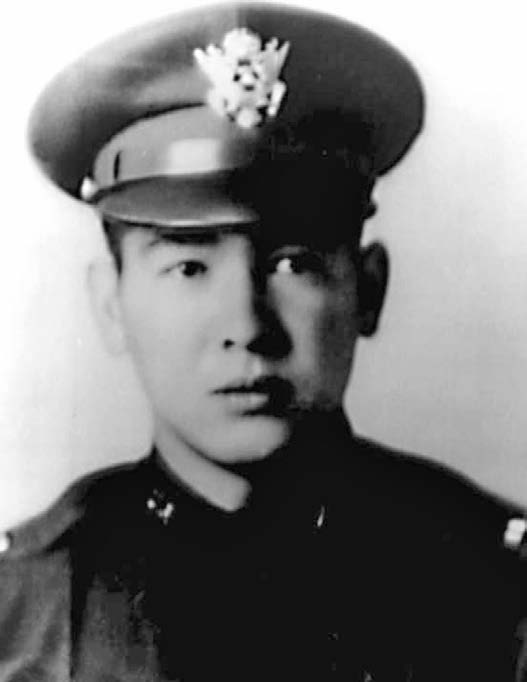
Captain Francis Wai
Born on April 14, 1917, in Honolulu, Hawaii, Captain Francis Wai was the son of a Chinese immigrant father and a native Hawaiian mother. He was commissioned as a second lieutenant in 1941 in the Hawaiian National Guard, which later became the 34th Infantry Regiment. When Japan attacked Pearl Harbor on December 7, 1941, the 34th Infantry Regiment was among the first to engage in combat.
During the landing at Red Beach, Leyte, Philippine Islands on 20 October 1944 Wai displayed extraordinary heroism. Upon finding the first four waves of soldiers disorganized and pinned down, he assumed command and led them through heavy enemy fire. Exposing himself to locate enemy strongholds, he inspired his men to follow him. During an assault on a Japanese pillbox, he was killed. Wai’s leadership played a key role in securing the beachhead.
Technical Sergeant Yeiki Kobashigawa
Technical Sergeant Yeiki Kobashigawa was born on September 28, 1917, in Hilo, Hawaii, to Japanese immigrant parents, and grew up working on a plantation. November 1941, the 298th Infantry Soldier was assigned to the Hawaiian Provisional Infantry Battalion. Kobashigawa’s military service was impacted by the Pearl Harbor attack, leading to Japanese Americans being separated into the 100th Infantry Battalion.
Kobashigawa displayed extraordinary heroism on 2 June 1944 near Lanuvio, Italy. During an attack, he identified and neutralized multiple enemy machine gun nests. He crawled forward to destroy the first nest, killing one enemy and capturing two prisoners. After being fired upon by another machine gun, Kobashigawa directed his squad to advance and, with his comrade, incapacitated the second nest, capturing four prisoners. He then led his squad to neutralize two additional machine gun positions.
After the war, Kobashigawa returned to Hawaii working for Hawaiian Cement and became a respected mentor. He passed away on March 31, 2005, and is buried in the National Memorial Cemetery of the Pacific.
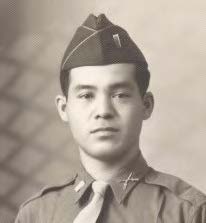
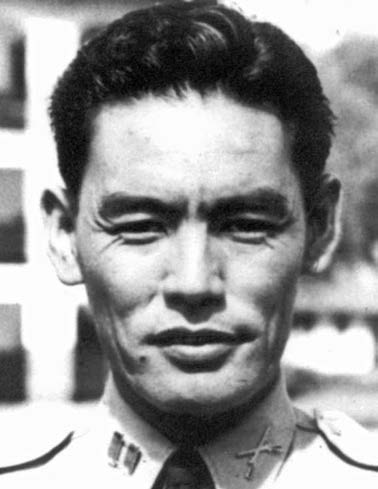
Sergeant Allan Ohata
Born on September 13, 1918, in Honolulu, Sergeant Allan Ohata was one of the 40 original Japanese members of the Hawaii National Guard Soldiers from the 298th Infantry who were mobilized on October 15, 1940. After the Pearl Harbor attack, he volunteered for the 100th Infantry Battalion and sailed to Europe in 1943.
Near Cerasuolo, Italy, on 29 and 30 November 1943 while defending his platoon’s left flank against an enemy force of 40 soldiers Ohata displayed extraordinary heroism. Despite heavy machine gun fire, he advanced 15 yards to assist a fellow soldier whose weapon had been damaged. Ohata killed 10 enemy soldiers and successfully covered his comrade’s withdrawal. Alongside the automatic rifleman, he killed 37 more enemy soldiers and captured three. The next day, Ohata helped stop another attack, killing four and wounding three.
After the war, he returned home to earn an engineering degree and worked for Northrop Aircraft and Lockheed. Ohata lived a quiet life, rarely speaking about his war experience. He died of colon cancer on October 17, 1977, at the age of 59.
Private Shinyei Nakamine
Private Shinyei Nakamine was born on January 21, 1929, in Waianae, Oahu. Nakamine served as a soldier in the 298th Infantry and was assigned to the Hawaiian Provisional Infantry Battalion.
Nakamine displayed extraordinary heroism on 2 June 1944 near La Torreto, Italy. When his platoon was pinned down by intense enemy machine gun fire, he crawled toward the enemy position and charged, killing three soldiers and capturing two. Later, Nakamine killed an enemy soldier on his platoon’s right flank and led an automatic rifle team toward a machine gun nest, capturing four soldiers. He then attempted to neutralize another machine gun nest but was killed by enemy fire.
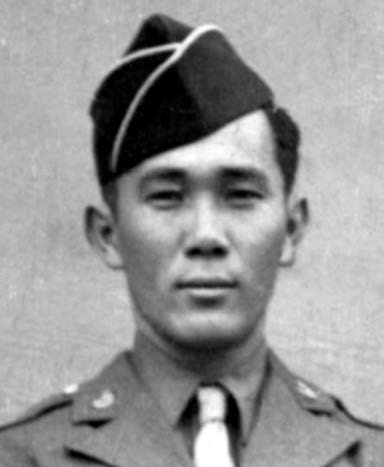
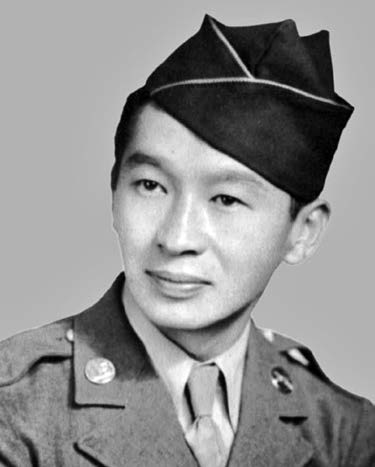
Private Masato Nakae
Born in Haena (Lihue), Kauai on December 20, 1917 was Private Masato Nakae a soldier in the 298th Infantry, assigned to the Hawaiian Provisional Infantry Battalion.
On 19 August 1944 near Pisa, Italy Nakae displayed extraordinary heroism. After his submachine gun was damaged, he used a wounded comrade’s M-1 rifle to fire grenades at the advancing enemy. Despite being seriously wounded by a mortar shell, Nakae refused to abandon his position, continued to fire, and threw six grenades, forcing the enemy to withdraw. His actions inflicted heavy casualties and helped break up the enemy attack.
After the war Nakae lived in Honolulu until he passed away on September 4, 1998, at the age of 80, and was buried at the National Memorial Cemetery of the Pacific.
Private First Class Karou Moto
Private First Class Karou Moto was born on April 25, 1917, in Spreckelsville, Maui. A soldier in the 298th Infantry, he was assigned to the Hawaiian Provisional Infantry Battalion.
Moto displayed extraordinary heroism on 7 July 1944 near Castellina, Italy. After identifying a machine gun nest hindering his platoon, he killed the gunner and captured the assistant gunner. While guarding a house, Moto repelled an enemy machine gun team and was wounded by an enemy sniper. Despite his injury, he continued to engage the enemy, wounding two soldiers at a machine gun nest. Moto then crawled forward to force their surrender.
Before his passing at the age of 75 on August 26, 1992, in Makawao, Maui, Moto donated all of his medals to the Fort DeRussy Army Museum. In 2004, the Pacific Army Reserve honored his legacy by naming the 32-year-old Maui Army Reserve Center in Wailuku after him.
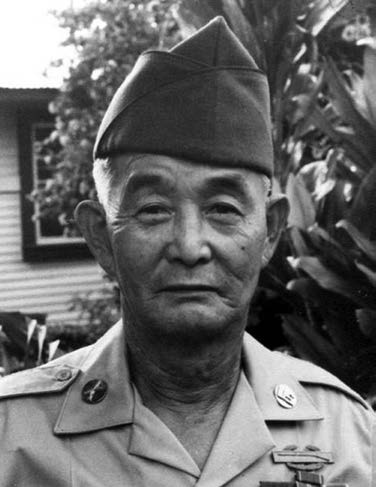
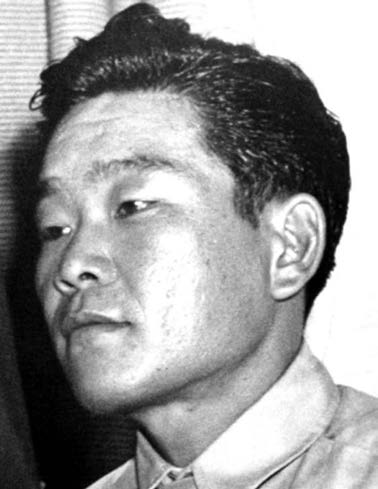
Private Shizuya Hayashi
On November 28, 1917, in Waiakea (Waialua), Oahu, where his parents worked at the Sugar Plantation Private Shizuya Hayashi was born. He was raised on the plantation and worked there after high school. Hayashi served as a soldier in the 298th Infantry, assigned to the Hawaiian Provisional Infantry Battalion.
On 29 November 1943 near Cerasuolo, Italy Hayashi displayed extraordinary heroism. During a flank assault, he charged an enemy machine gun position, killing seven soldiers and two more as they fled. After his platoon advanced, an enemy antiaircraft gun opened fire, and Hayashi responded by killing nine enemy soldiers, capturing four prisoners, and forcing the rest to withdraw.
He passed away on March 12, 2008, at the age of 90 and is buried at the National Memorial Cemetery of the Pacific.
The Medal of Honor is awarded only on rare occasions and is given to those who demonstrate exceptional courage and valor. In the last 165 years, since the medal was first authorized less then 3,500 have been awarded.
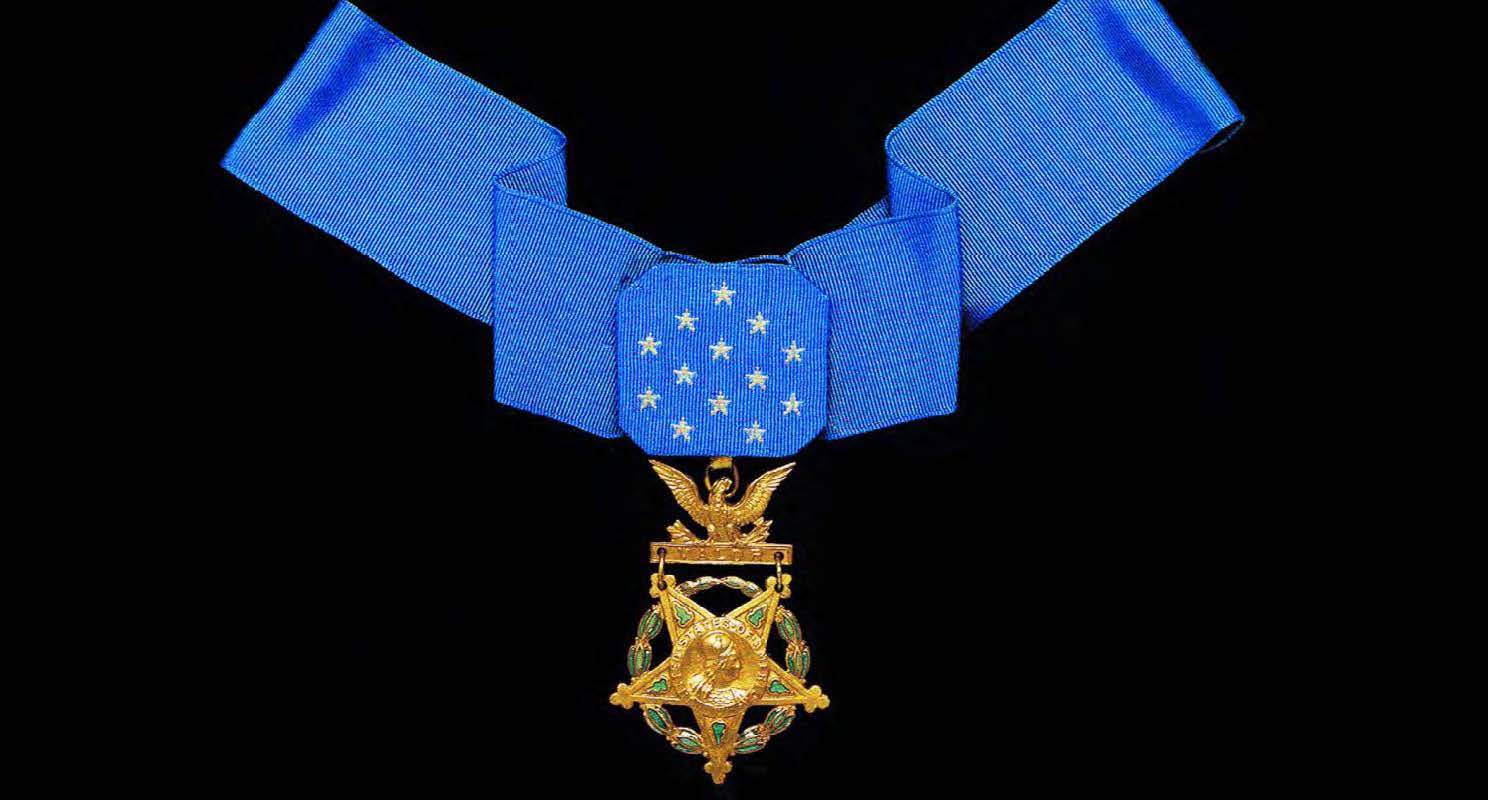
HAWAI‘I AIR NATIONAL GUARD
Airmen who flew Firework Disaster Survivors are Thanked
State of Hawai‘i, Department of Defense Public Affairs Office | Story by Rachel Blaire | February 2025

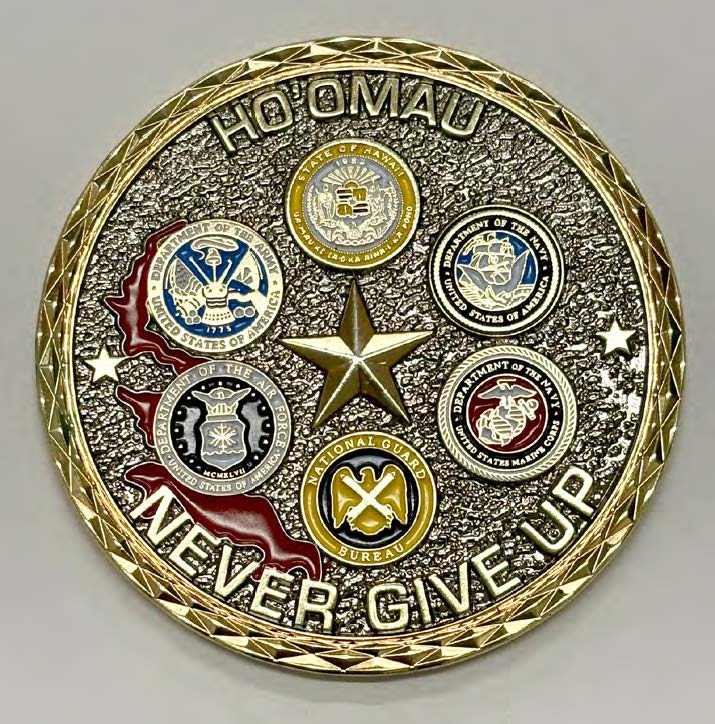

Survivors of the Aliamanu (Salt Lake) fireworks disaster were flown to an Arizona burn center aboard a C-17 military aircraft for critical treatment. The operation required meticulous coordination, including military ambulance support that utilized both standard ambulances and a specialized ambulance bus to transport patients from Queen’s Medical Center and Straub Benioff Medical Center to Joint Base Pearl Harbor-Hickam. From there, the survivors were flown to Arizona for advanced care.
Two Burn Flight Teams (BFTs) from the prestigious Brooke Army Medical Center Burn Unit in San Antonio, Texas, accompanied the patients, along with a Critical Care Air Transport Team (CCATT). The CCATT, a specialized team capable of converting an aircraft into a mobile ICU, ensured that patients received continuous, high-level care throughout the flight. The BFTs, consisting of skilled nurses, respiratory therapists, and burn treatment physicians, collaborated closely with the CCATT to ensure smooth and safe transport for the survivors.
This critical mission involved a collaborative effort among military medical personnel, aircrews, and ground support teams, including active duty and Hawai‘i Air National Guard members, working alongside civilian authorities to provide the necessary care.
Brig. Gen. Walter R. Ross Jr. recently visited the Brooke Army Medical Center and the Center’s Burn Flight Unit. During his visit, he met the BFT responsible for aeromedical care during the transport of six burn patients from Hawai‘i to Arizona. To honor their outstanding service, Ross presented the team members with a special military coin in recognition of their exceptional care.
The special military coin features the word Ho‘omau which means to persevere or to carry on, and has seals from the State of Hawai‘i and the five U.S. military branches. Ross said, “this coin was very fitting to give to the BFT members as they personally understand what it means to persevere”. He was able spend time talking story and thanking them for the help they provided.
HAWAI‘I AIR NATIONAL GUARD
Palace Alert: The Guardians of the Skies
A Tribute to Hawai‘i National Guard Vietnam Veterans – Vietnam Veterans Day honors the sacrifices made by Vietnam veterans and their families, serving as part of a broader national effort to acknowledge the men and women who were denied a proper welcome upon returning home more than four decades ago. The Vietnam War Veterans Recognition Act officially designates March 29 as National Vietnam War Veterans Day each year. This marks the day in 1973 when the last combat troops were withdrawn from Vietnam, and the final prisoners of war held in North Vietnam returned to the United States. – State of Hawai‘i, Department of Defense Public Affairs Office | Story by Rachel Blaire | Saturday, March 29, 2025
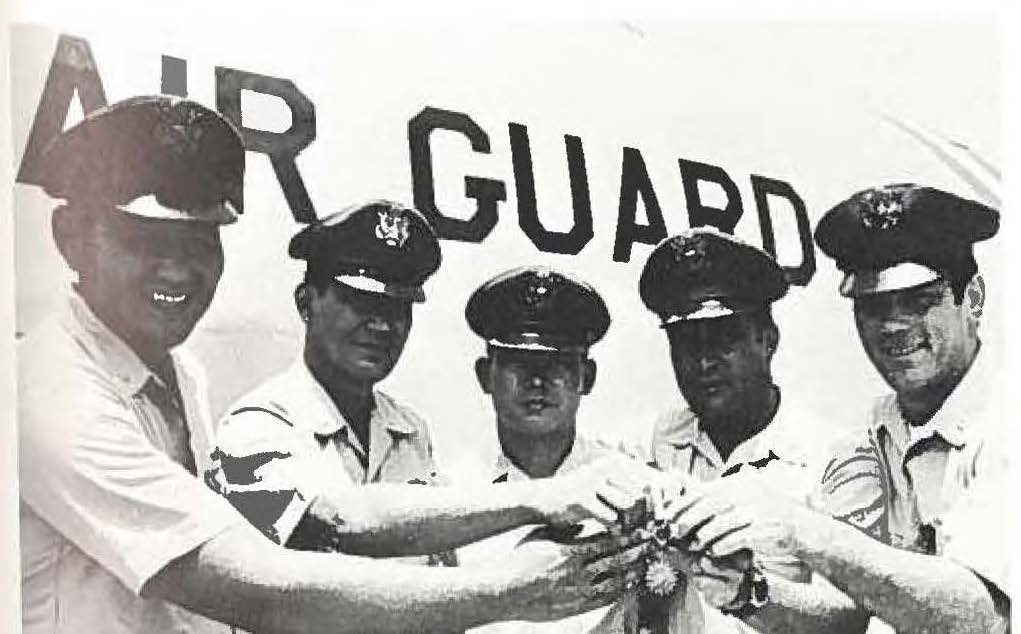
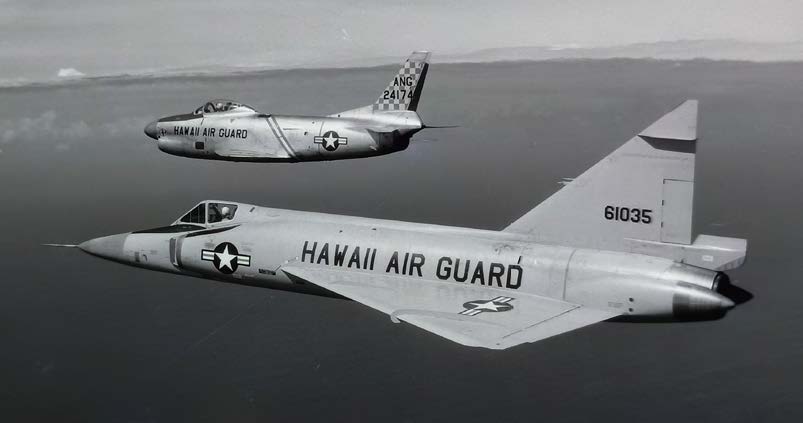

Fifty-seven years ago in the summer of 1968, the United States was deeply involved in the conflict in Southeast Asia. With air defense needs growing across the region, a new initiative known as Palace Alert was launched — an innovative partnership between the Pacific Air Force and the Hawai‘i Air National Guard (HIANG). The goal was clear: augment the U.S. Air Force’s fighter-interceptor forces with highly trained pilots from the Air National Guard, ready to serve in vital roles without a full mobilization of active-duty forces.
The HIANG’s 154th Fighter Group, particularly the 199th Fighter Interceptor Squadron, was uniquely equipped to take on this challenge. Their F-102 Delta Dagger jets were the backbone of air defense in the Pacific, and the pilots were prepared for combat. Palace Alert would see many of them travel to combat zones in Southeast Asia, joining the fight while gaining invaluable combat experience.
The first two volunteers from HIANG were Major Jon G. Parrish and Major Gerald K. Sada, who in July 1969 were deployed to Clark Air Force Base (AFB) in the Philippines. From there, they flew missions out of Da Nang AFB in South Vietnam, engaging in air defense duties over hostile territory.
The mission of these pilots, alongside their colleagues, was to provide vital air superiority, defend U.S. and allied forces, and disrupt the enemy’s supply lines. Their contributions were recognized with Air Medals and Oak Leaf Clusters, a testament to their exceptional service.
As the program grew, Major Ritchie K. Kunichika became one of the next volunteers. Kunichika, a highly skilled fighter pilot with the 154th Fighter Group at Hickam Air Base, flew a 95-day combat tour in Vietnam, and he became one of the program’s standout participants.
“Yeah, I’d like to go back,” Kunichika remarked with determination after returning from his tour. “We’re over there for a reason. There’s a job to be done, and I’d like to get my two cents in.”
His enthusiasm for the mission was palpable, even after seeing the intense nature of combat firsthand. Kunichika, along with Captain Rexford F. Hitchcock, served as two of the Hawai‘i Air National Guard’s pilots attached to the Palace Alert program, flying missions out of Da Nang Air Base, located near the North Vietnam border.
Kunichika flew approximately 50 sorties, many of them as part of bombing escort missions for heavy bombers targeting enemy supply lines. “As soon as you take off, you can see artillery and machine gun fire,” Kunichika recalled.
“The area was infested with Viet Cong, and both night and day, we’d see rockets and small arms fire hitting their positions.”
Though Kunichika was a seasoned pilot, having flown F-86s and F-102s since 1958, his time in Vietnam gave him a new perspective on warfare and the importance of the Palace Alert program. The experience was not just about flying combat missions; it was about contributing to a broader effort.
“We were there to make a difference,” Kunichika said, reflecting on the purpose that drove him and his fellow pilots to volunteer.
By the time the program ended, more than 100 combat-qualified F-102 pilots from across the nation had participated, augmenting the U.S. Air Force’s ability to maintain air superiority in some of the most challenging environments of the Cold War. And for the pilots of the Hawai‘i Air National Guard, their legacy in Palace Alert endures—each flight, each sortie, a small but vital piece in the broader picture of defending freedom and securing the peace.
References: Annual Report Department of Defense State of Hawai‘i Fiscal Year 1969, HANG 25 History of Hawai‘i Air National Guard, the Hawai‘i Guardsman Fall 1968 and the Hawai‘i Guardsman Spring 1969
HAWAI‘I AIR NATIONAL GUARD
Hawai‘i Air National Guard Sentry Aloha 25-01 Bolsters Agile Combat Employment with Enhanced Mission Readiness
154th Wing, Hawai‘i Air National Guard | Story by Senior Airman Roann Gatdula | Tuesday, Feb. 18, 2025
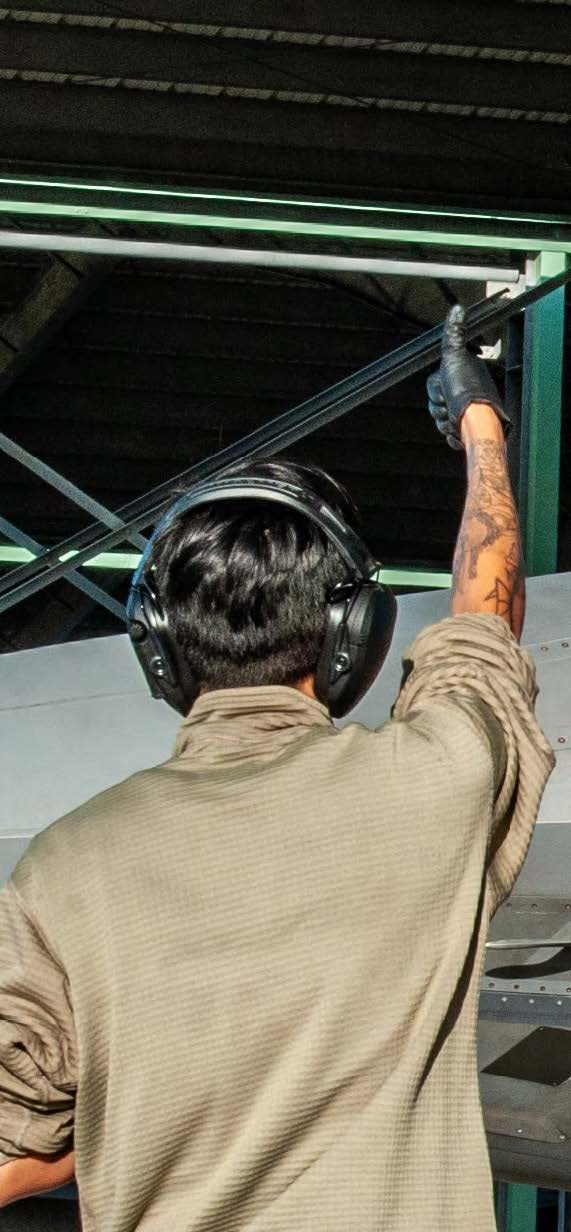 U.S. Air Force Senior Airman Feilanie Felicitas, 154th Aircraft Maintenance Squadron, tactical aircraft mechanic, signals for all clear to a U.S. Air Force F-22 Raptor assigned to the 199th and 19th Fighter Squadrons at Joint Base Pearl Harbor-Hickam, Hawaii, on Feb. 11. 2025, during Sentry Aloha 25-1. Fighter jets, tankers, and support units participated in simulated combat scenarios, enhancing interoperability and readiness among U.S. military forces. (U.S. Air National Guard photo by Senior Airman Roann Gatdula
U.S. Air Force Senior Airman Feilanie Felicitas, 154th Aircraft Maintenance Squadron, tactical aircraft mechanic, signals for all clear to a U.S. Air Force F-22 Raptor assigned to the 199th and 19th Fighter Squadrons at Joint Base Pearl Harbor-Hickam, Hawaii, on Feb. 11. 2025, during Sentry Aloha 25-1. Fighter jets, tankers, and support units participated in simulated combat scenarios, enhancing interoperability and readiness among U.S. military forces. (U.S. Air National Guard photo by Senior Airman Roann Gatdula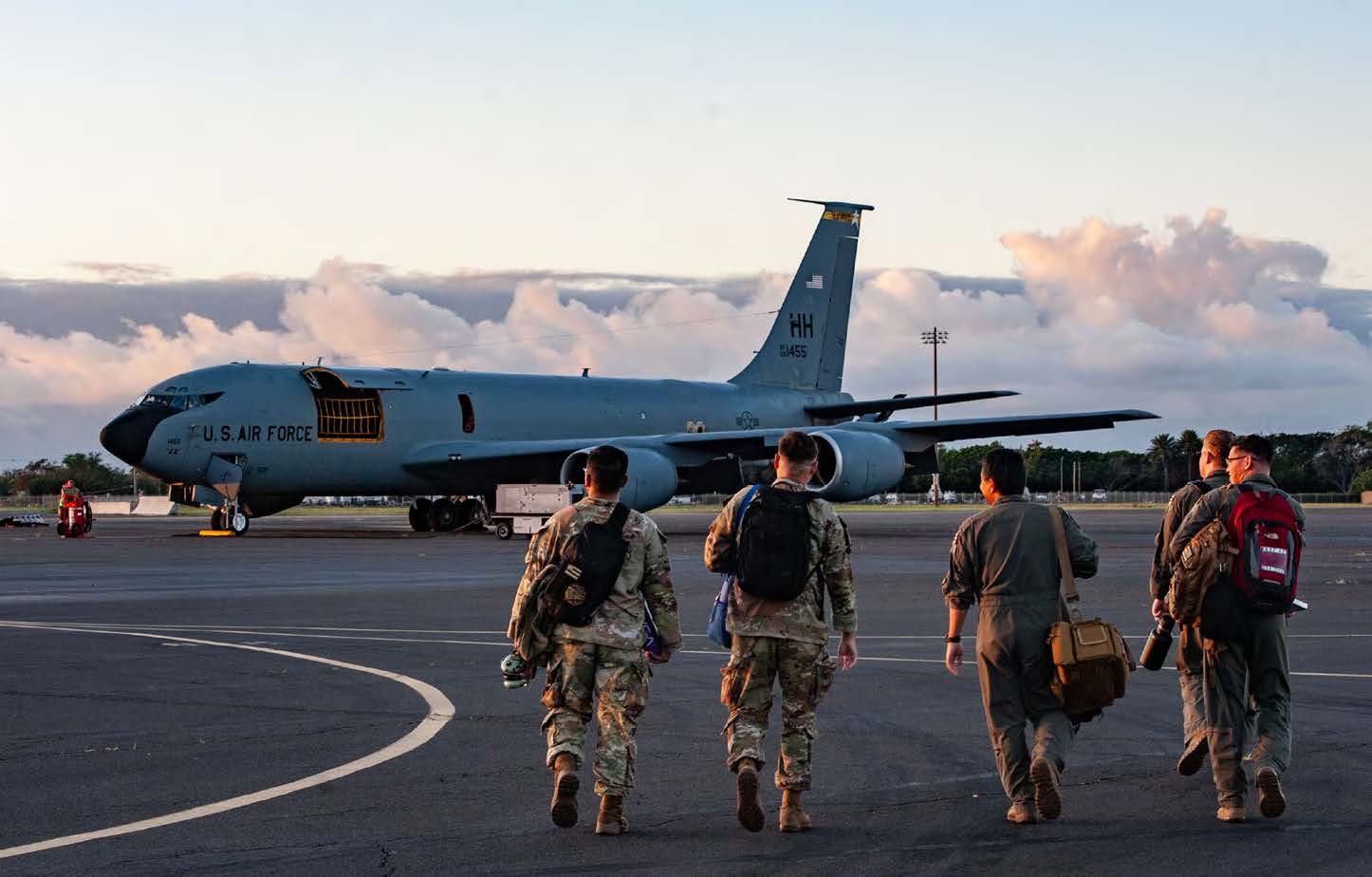
U.S. Air Force Airmen from the 203rd Air Refueling Squadron and the 169th Air Defense Squadron approach a U.S. Air Force KC-135 Stratotanker assigned to the 203rd Air Refueling Squadron at Joint Base Pearl Harbor-Hickam, Hawaii, on Feb. 5, 2025 for Sentry Aloha 25-1. Fighter jets, tankers, and support units participated in simulated combat scenarios, enhancing interoperability and readiness among U.S. military forces. (U.S. Air National Guard photo by Senior Airman Roann Gatdula)
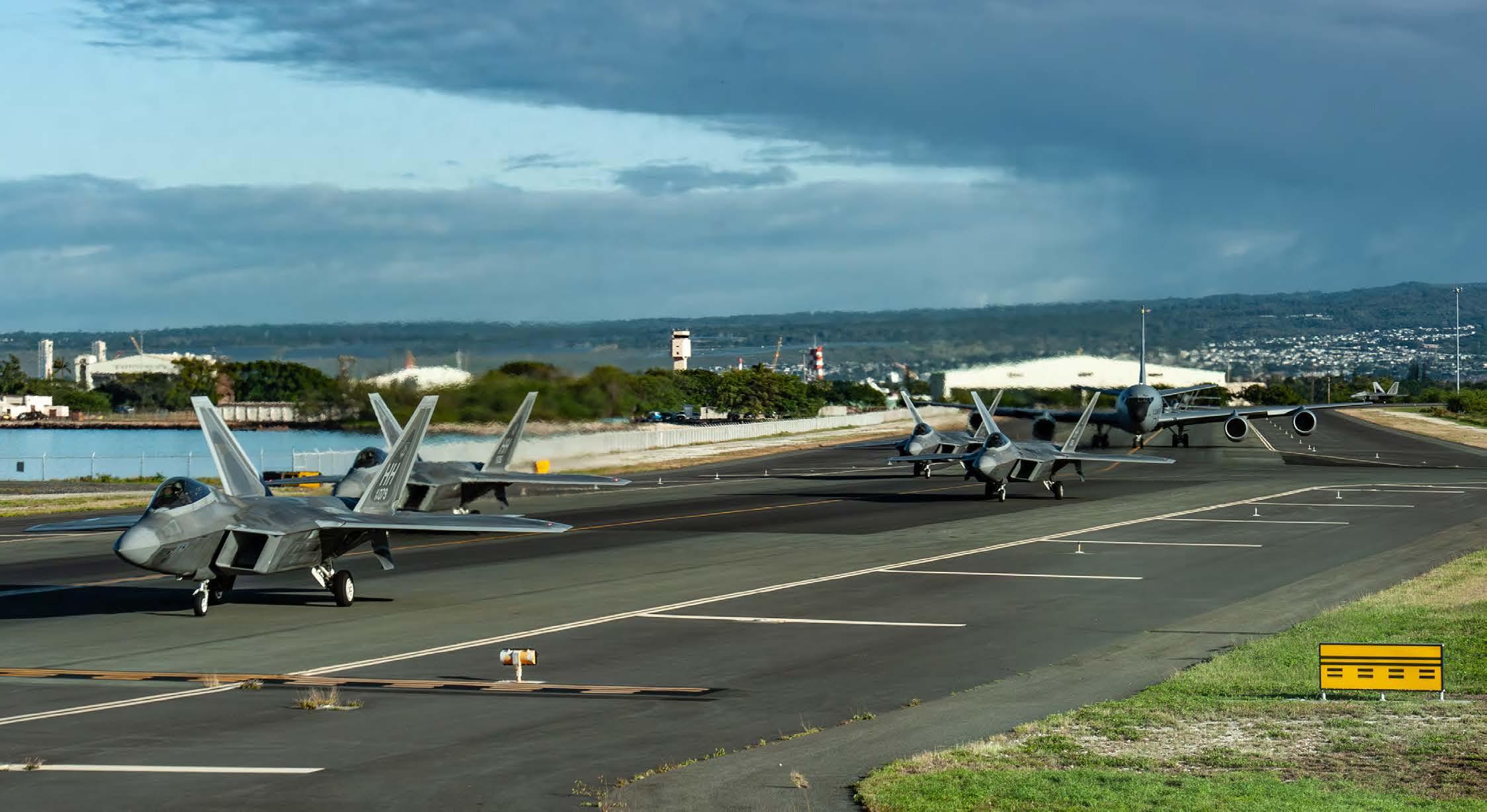 U.S. Air Force F-22A Raptors assigned to the 199th Fighter Squadron, operated by members of the 199th and 19th Fighter Squadrons, and a KC-135 Stratotanker assigned to the 203rd Air Refueling Squadron taxi the runway at Joint Base Pearl Harbor-Hickam, Hawaii, on Feb 5, 2025 for Sentry Aloha 25-1. Fighter jets, tankers, and support units participated in simulated combat scenarios, enhancing interoperability and readiness among U.S. military forces. (U.S. Air National Guard photo by Senior Airman Roann Gatdula)
U.S. Air Force F-22A Raptors assigned to the 199th Fighter Squadron, operated by members of the 199th and 19th Fighter Squadrons, and a KC-135 Stratotanker assigned to the 203rd Air Refueling Squadron taxi the runway at Joint Base Pearl Harbor-Hickam, Hawaii, on Feb 5, 2025 for Sentry Aloha 25-1. Fighter jets, tankers, and support units participated in simulated combat scenarios, enhancing interoperability and readiness among U.S. military forces. (U.S. Air National Guard photo by Senior Airman Roann Gatdula)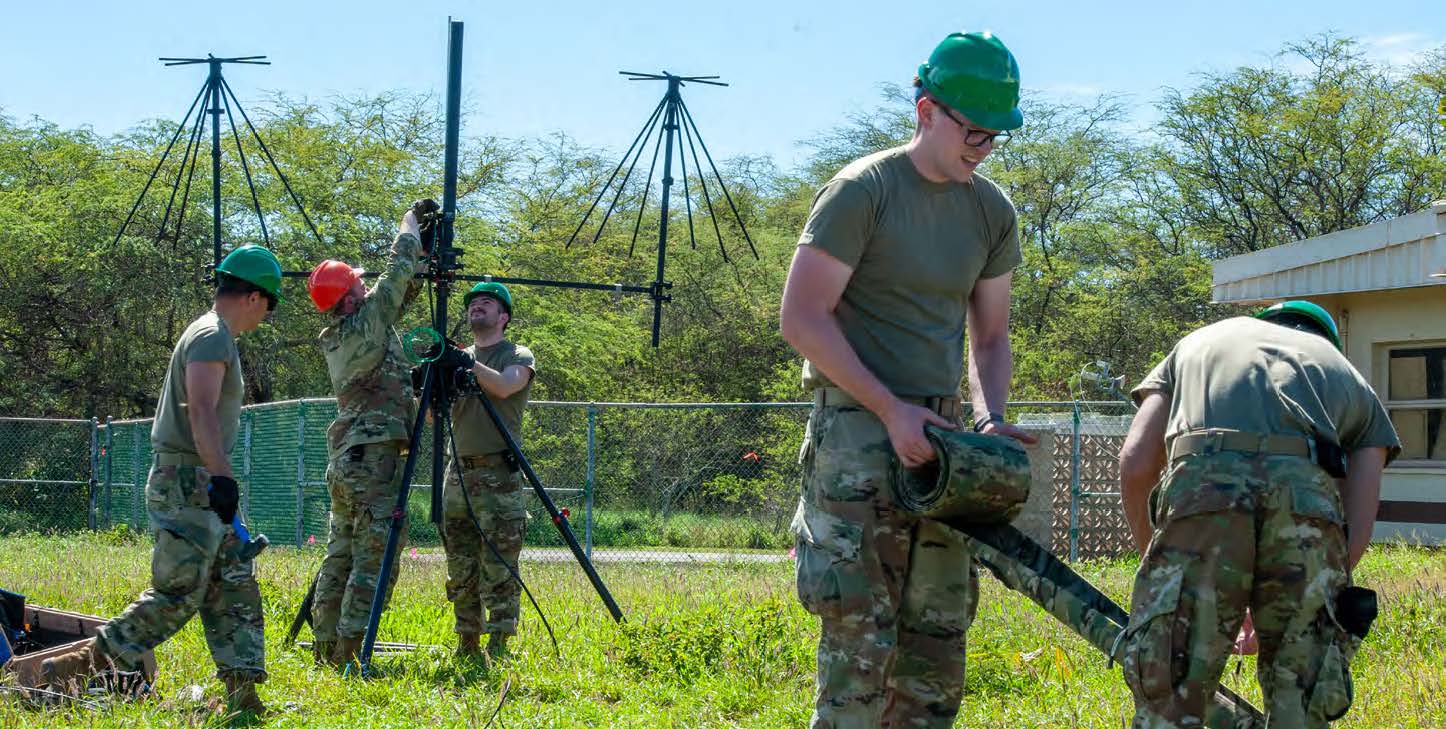
U.S. Air Force Airmen from the 103rd Air Control Squadron set up a cloud-based radar and radio connection of the Tactical Operations Center-Lite (TOC-L), on Feb. 6, 2026 for Sentry Aloha 25-1 at the Pacific Missile Range Facility, Hawaii. TOC-L is a mobile battle management system that allows for decentralized teams to control airspace. (U.S. Air National Guard photo by Senior Airman Roann Gatdula)

The Hawai‘i Air National Guard’s (HIANG) 154th Wing successfully concluded their long running defense readiness exercise Sentry Aloha at Joint Base Pearl Harbor-Hickam, Hawaii, on Feb. 12, 2025.
Designated Sentry Aloha 25-1, this iteration began Jan. 29 and brought approximately 800 joint personnel including Guardsman, Reservists, locally-based active duty partners from the 15th Wing, Sailors and Marines and nearly 30 aircraft from six states.
For more than 20 years, Sentry Aloha is an ongoing series of exercises that enable tailored, cost effective and realistic combat training for Air National Guard, U.S. Air Force and other Department of Defense services. It provides U.S. war fighters with the skill sets necessary to perform homeland defense and overseas combat missions.
Sentry Aloha is built around Dissimilar Air Combat Training (DACT), which challenges pilots to engage in combat scenarios against aircraft with different performance capabilities. Rather than training against identical airframes, DACT forces pilots to adapt to unpredictable engagements, testing their ability to exploit their own platform’s strengths while capitalizing on adversary weaknesses.
The exercise operates at an intense tempo, with participants generating back-to-back combat training sorties daily. This high-paced battle rhythm ensures pilots experience continuous exposure to varied threats, refining their decision-making, reaction times and overall combat effectiveness in a dynamic and ever-evolving air combat environment.
Guest participants included U.S. Navy F-35C Lightning II’s from California, and U.S. Air National Guard KC-135 Stratotankers from Washington and Mississippi. Visiting aircraft took part in simulated combat exercises with F-22A Raptors operated by the 199th and 19th Fighter Squadrons’ Hickam-based “Hawaiian Raptors.”
Joint maintenance teams launched, recovered, and maintained the diverse fleet of aircraft — comprising fifth-generation fighters, refueling tankers, and cargo aircraft for support and logistic capabilities — ensuring a seamless flow of sorties and a full-spectrum air combat scenario.
The successful execution of these flight operations highlights the importance of Hawaii’s strategic location and training environment.
“Hawai‘i offers great weather, especially over-water airspace to train in the Indo-Pacific Theater, as well as the opportunities to practice those agile combat employment tactics, techniques, and procedures,” said U.S. Air Force Lt. Col. Matthew Ohman, 201st Combat Operations Squadron, Sentry Aloha senior director, “The Hawaiian Raptors rely heavily on these exercises to accomplish mission readiness – it’s a culmination of a lot of training.”
During this iteration of Sentry Aloha, the 169th Air Defense Squadron provided a team of Battle Management Operators aboard the KC-135 for the first time, delivering non-traditional tactical command and control to the forward edge. From the airborne platform, they relayed near real-time situational awareness provided via beyond line of sight communications by Air Battle Managers and Battle Management Operators on the ground utilizing a simulated Common Operational Picture, exercising fight tonight capabilities.
“The HIANG must continue to integrate,” said U.S. Air Force Tech. Sgt. Kukila Carreira-Manin,169th ADS, weapons and tactics NCO-in-charge, “Every service member within USINDOPACOM has a significant responsibility to support each other from every aspect in every rank. Time is precious within this theater and every second counts building our relationships with one another.”
The daily tanker support provided served as a force-multiplier, enabling fighter aircraft to extend their range and mission duration without the need for frequent landings to base, reducing congestion at the airport and creating efficient flight operations. By providing in-flight refueling, tankers allow participants to maximize their flight hours, conduct more extensive training scenarios, and remain engaged in exercises for longer periods to enhance operational effectiveness.
Agile Combat Employment (ACE) concepts were deployed and rehearsed among participants across the Hawaiian Islands. Among these systems were the implementation of a Tactical Operations Center-Lite (TOC-L) brought in by the 103rd Air Control Squadron from the Connecticut Air National Guard.
The mobile system is designed to be compact and ready for rapid deployment and advanced airspace tactical control. Unlike traditional systems that require extensive infrastructure and staffing, TOC-L integrates cloud-based command and control capabilities, enabling seamless operations worldwide. It can be packed into about two dozen hand-carried cases and be operational within an hour with minimal personnel.
“It was our most ambitious TOC-L execution to date,” said U.S. Air Force Maj. J. Seth Bopp, 103rd Air Control Squadron director of operations. “The team planned for months and built off of what they learned from similar exercises, such as AGILE PANDA, NIMBLE CHEETAH, MOBILE MARLIN, and SENTRY SAVANNAH. They did it faster and did it with more sites. We couldn’t have done it without our joint partners from the U.S. Marine Corps and the U.S. Space Force who acted as force enablers for our proof of concept.”
The 103rd ACS exercised a morning vulnerability from Kaneohe Marine Corps Base on Oahu, disassembled equipment, deployed from Oahu on a KC-130J Hercules to the Pacific Missile Range Facility on the neighboring island of Kauai, control vulnerability, and re-deployed back to Oahu in a five-hour window.
“Doing all of that in a short window across two islands was paramount in proving ACE concepts for TOC-L,” said Senior Master Sgt. Jonathan Burr, 103rd Air Control Squadron senior enlisted leader. “Traveling out from our home base in Connecticut and across the Hawaiian Islands, the team had to jump through hoops to make things happen and they were exceptional.”
Over a two-week span, the 103rd ACS trained and tested at three locations across two islands, and ended with four locations across three islands. It was the first time a unit was able to remote in two radio sites.
“I would say the 103rd definitely showed up ready to work and utilize their TOC-L system to kind of be the highlights, it’s definitely something new and different that we haven’t really done before.” said Ohman, “Everyone showed up and did the job they were ready and trained to do. I definitely would give credit to our tankers, it didn’t seem like during the exercise we had many or any tanker cancellations, but the tankers seemed to be flying well throughout the entire exercise.”
With 182 sorties flown and well over 300 flight hours logged, Sentry Aloha 25-1 successfully enhanced combat readiness and interoperability among participating units. The second phase of this year’s training is projected to be held in the first half of this year, bringing another opportunity to refine warfighting capabilities in the Indo-Pacific region.
HAWAI‘I ARMY NATIONAL GUARD
A Call to Duty: The 1968 Activation of the 29th Infantry Brigade, Hawai‘i National Guard
A Tribute to Hawai‘i Army National Guard Vietnam Veterans – Vietnam Veterans Day honors the sacrifices made by Vietnam veterans and their families, serving as part of a broader national effort to acknowledge the men and women who were denied a proper welcome upon returning home more than four decades ago. The Vietnam War Veterans Recognition Act officially designates March 29 as National Vietnam War Veterans Day each year. This marks the day in 1973 when the last combat troops were withdrawn from Vietnam, and the final prisoners of war held in North Vietnam returned to the United States. – State of Hawai‘i, Department of Defense Public Affairs Office | Story by Rachel Blaire | Saturday, March 29, 2025
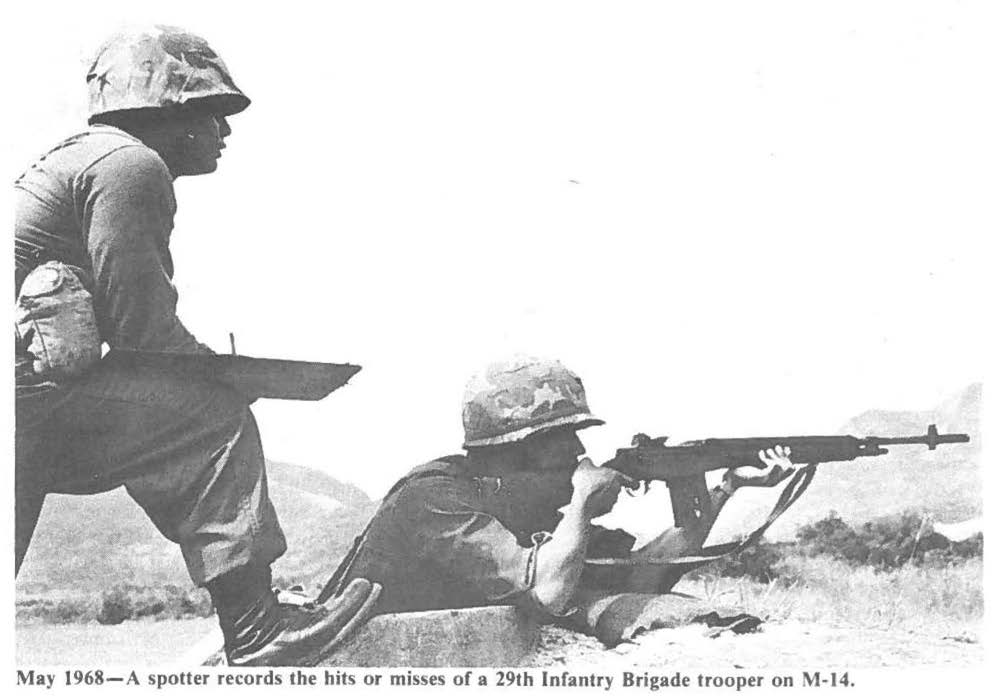
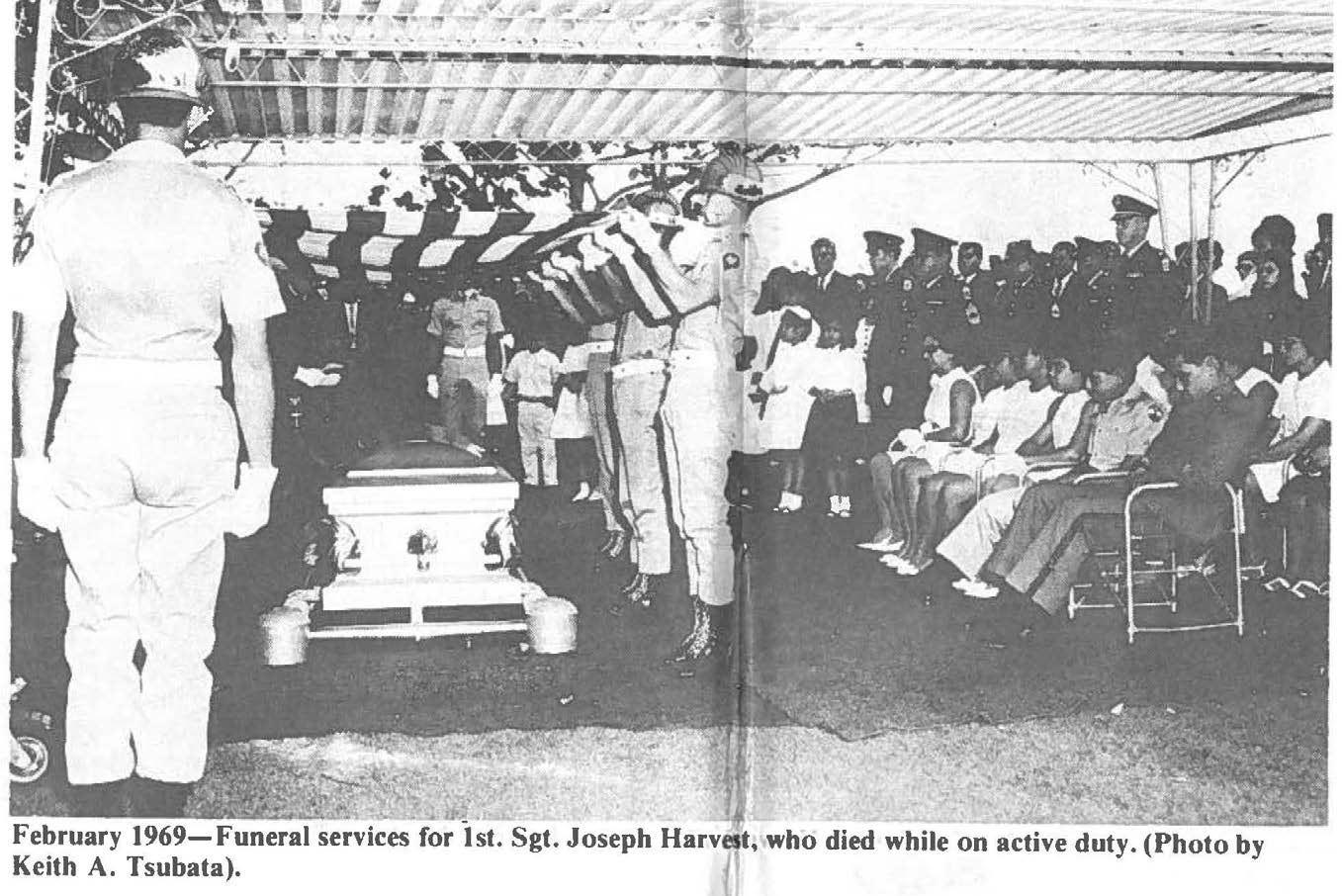
The morning of April 11, 1968, dawned like any other on the islands. Yet a headline in the Honolulu Star-Bulletin would change the future for many, it read: ISLE NATIONAL GUARD UNIT ACTIVATED.
The last time the Hawai‘i National Guard had been mobilized was during the days of World War II. But in the spring of 1968, amidst the swirling tensions of a nation torn by the conflict in Vietnam, the 29th Infantry Brigade known as “Hawaii’s Own,” was ordered to report for federal service.
The announcement sent ripples through the local community. For the soldiers of the Hawai‘i National Guard, it meant leaving behind their civilian lives as — doctors, teachers, lawyers, and postmen — to answer the call of duty.
The national call-up saw the activation of 24,500 National Guardsmen and Army Reservists across the United States, including soldiers from the 29th Infantry Brigade, who were “levied” to replace units already deployed to Vietnam
The 29th Infantry Brigade, under the command of Brigadier General Frederick A. Schaefer III, was made up of: 187 officers, 21 warrant officers, and 2,760 enlisted men.
The call to active duty on May 13, 1968, marked the beginning of an intense period of transformation. What began as an island-based militia became a full-fledged combat-ready force, training tirelessly to meet the demands of federal service.
The sheer scale of the mobilization led to criticism from some, with observers noting that Hawaii’s share of the call-up seemed disproportionate compared to the national average. But as the months wore on, these criticisms were quelled by the professionalism and dedication that the 29th Infantry Brigade displayed throughout their preparations.
Chief Warrant Officer Paul N. Kahunahana remembered the sense of unity and duty, “We were called to do our job and that’s what we did. It made us realize that we had to depend on each other to make it through.”
Training began in earnest at Schofield Barracks, where the soldiers faced the immediate task of adapting to new weapons and equipment. One of the grueling but essential aspects of their training came in late May when the 29th began its jungle training at the Pohakuloa Training Area. This was not just physical conditioning, it was a mental and emotional trial, testing the soldiers’ ability to endure in the harshest conditions.
A major milestone of their service came in late August when the Brigade sent its first group of men to Vietnam. While the sense of loss was palpable, these early departures only served to reinforce the seriousness of their mission.
By December 1968, after months of intense training and preparation, the 29th Infantry Brigade was ready for its ultimate test. The soldiers of the Brigade conducted a full-scale exercise, simulating an assault on a beachhead. The soldiers demonstrated their capabilities, executing the operation with precision and professionalism.
Brigadier General Frederick A. Schaefer received orders for deployment to Vietnam, a bittersweet moment for the 29th. On Jan. 9, 1969, at the activation ceremony, “There was a whole lot of leis, loved ones… a lot of Aloha,” Schaefer said.
In total, 1,100 Hawai‘i Guardsmen served in Southeast Asia and Korea between 1968 and 1969. The 29th Infantry Brigade’s mobilization had far-reaching impacts, as the soldiers found themselves in unfamiliar and often dangerous environments. Twenty-nine members of the brigade lost their lives during their service, and one became a prisoner of war.
As 1969 drew to a close, and with the announcement of demobilization set for December, the 29th Infantry Brigade had undergone a transformation that few could have imagined when they first answered the call. They were no longer civilian soldiers; they were veterans, having faced the trials of war and the bonds of brotherhood.
On Dec. 13, 1969, the Brigade officially reverted to its state status, marking the conclusion of its federal service and the end of a chapter that had forever changed the men of Hawaii’s National Guard.
Despite the hardships, the 29th Infantry Brigade excelled during its federal service. It was recognized for its professionalism and dedication, earning the Army National Guard Meritorious Service Award from the National Guard Bureau on March 5, 1970.
In total, the Brigade earned numerous medals and awards during its federal service, including 40 Purple Hearts, 187 Bronze Stars, and 87 Air Medals. The bravery and sacrifice of the men of the 29th was etched into history.
As the Brigade began rebuilding its units, recruiting new personnel, and receiving new equipment, the story of the 29th was far from over. The spirit of the unit, forged through sacrifice and camaraderie, would continue to guide them as they moved forward.
References: 1968 Annual Report, 1969 Annual Report, 1970 Annual Report, 1993 April – May pūpūkahi, and 1998 April – August pūpūkahi
HAWAI‘I AIR NATIONAL GUARD
Hawai‘i Air National Guard, Indonesian Air Force Advance Partnership with Second Year of Air-To-Air Refueling Engagement
154th Wing, Hawai‘i Air National Guard | Story by Master Sgt. Mysti Bicoy | Sunday, February 23, 2025
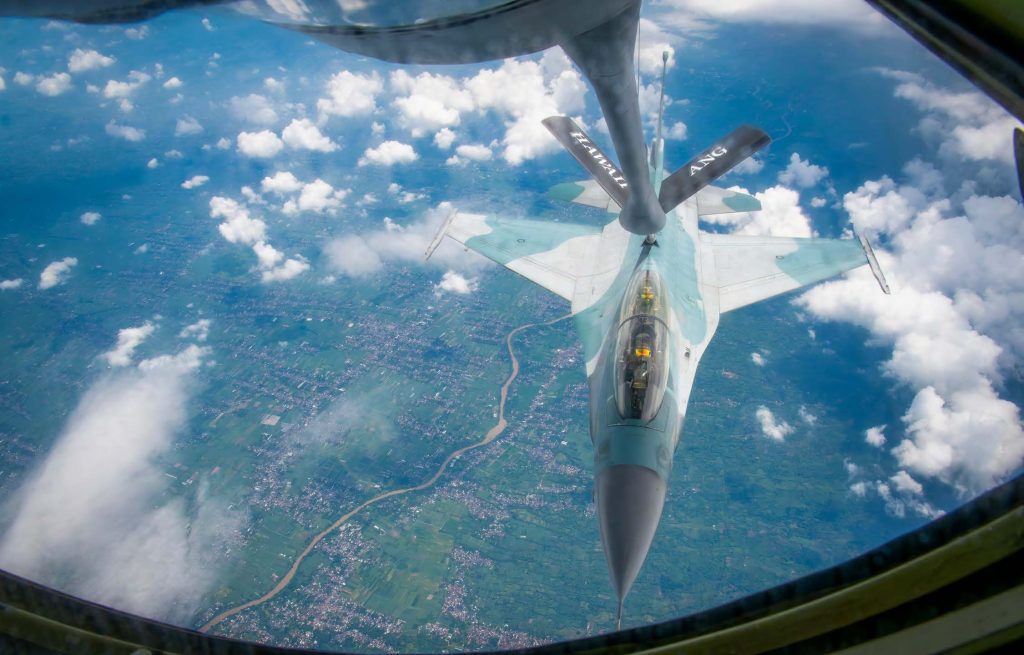

DENPASAR, Indonesia – Hawai‘i Air National Guard personnel from the 154th Wing participated in air-to-air refueling engagement with the Indonesian Air Force (IDAF) as part of efforts to support F-16 recertification requirements identified during the 2024 Airmen-to-Airmen Talks. The training focused on strengthening interoperability, operational effectiveness, and regional security efforts between the two forces in Denpasar, Indonesia in Feb. 17-21.
This engagement was part of the Hawai‘i National Guard’s State Partnership Program (SPP), which has played a critical role in advancing air-to-air refueling capabilities between Hawai‘i ANG and the Indonesian Air Force.
In this training cycle, five new and 21 IDAF F-16 pilots successfully earned their air-refueling qualifications. The 203rd Air Refueling Squadron (ARS) directly supported over 40 F-16 sorties, demonstrating the increasing complexity and operational integration of these joint capabilities.
“For many of us, this mission isn’t just about fuel transfers — it’s about trust, adaptability, and building a foundation for future interoperability,” said 1st Lt. Alison Bowman, a pilot with the 203rd ARS. “Through pre- and post-mission briefings, we are exchanging air refueling tactics, techniques, and procedures to enhance operational efficiency.”
For the 203rd ARS, this mission extended beyond technical proficiency—it was an engagement in adaptability and cross-cultural collaboration in a region with unique airspace and logistical challenges.
“Air refueling engagements in this region gives us a great opportunity to fine-tune our skills while working closely with our partners in a dynamic environment,” said Tech. Sgt. Angellica Amian, 203rd ARS inflight refueler. “By staying in constant communication and giving each other real-time feedback, we were able to work together more smoothly. It’s all about building that trust and understanding so we can operate effectively as a team.”
As the engagement progressed, both air forces refined their air domain awareness capabilities, reinforcing their commitment to regional stability.
“This opportunity not only strengthens our operational readiness but also ensures we have the capabilities to secure our territorial integrity,” said Lt. Col Ripdho “Mohawk” Utomo, IDAF exercise planner. “We want to thank the Hawai‘i Air National Guard for their support to maintain our currency and certifications. I’m looking forward to continuing this cooperation.”
The Hawai‘i National Guard State Partnership Program – Indonesia Military Bilateral Partnership, established in 2006 through the National Guard Bureau, continues to serve as a key initiative supporting USINDOPACOM’s goal of enhancing defense relations and strengthening Indonesia’s military capabilities.
As the training concluded, the Hawai‘i Air National Guard reaffirmed its commitment to fostering international partnerships through high-level military operations, activities, and investments. Working alongside allies such as Indonesia, Hawai‘i Air National Guard continues to support global stability and operational excellence in air mobility and aerial refueling capabilities.
Looking ahead, future training opportunities will build upon the progress achieved during this exercise, further advancing U.S.-Indonesia defense cooperation. With continued collaboration and shared training objectives, both air forces are committed to strengthening regional security, enhancing readiness, and improving interoperational capabilities for future missions.
HAWAI‘I NATIONAL GUARD
Hawai‘i Guardsmen Support INDOPACOM in Deepening Defense Cooperation with Indonesia
154th Wing, Hawai‘i Air National Guard | Story by Tech. Sgt. John Linzmeier | Friday, January 31, 2025




Soldiers and Airmen from the Hawai‘i National Guard’s (HING) State Partnership Program supported the annual U.S. Indonesia Bilateral Defense Discussions (BDD) in Jakarta, Indonesia, on Jan. 23-24, 2025.
Senior leaders from U.S. Indo-Pacific Command (USINDOPACOM) and the Tentara Nasional Indonesia (TNI) met to establish bilateral operations activities and investments (OAIs) for calendar year 2025 in an effort to deepen ties through interoperability, capacity building, and institutional linkages.
“I extend my appreciation for the hard work and dedication demonstrated by our working group members throughout this meeting,” said the Assistant for Operations to the Panglima TNI (ASOPS), Maj. Gen. Gabriel Lema, highlighting the enduring partnership between the U.S. and Indonesia.
The Hawai‘i National Guard’s participation, formalized through the State Partnership Program in 2006, and supported by the HING SPP Bilateral Affairs Officer, serves as a cornerstone for fostering collaboration and mutual growth, especially in addressing shared challenges such as natural disasters and emerging security threats.
Functional working groups discussed specific programs and training initiatives: medical, logistics, intelligence, communications, education, training and exercises, with Guardsmen providing medical professionals, translation services, information operations, and administrative support. Experts from these fields engaged in discussions with their counterparts, fostering knowledge exchange and collaboration between the two nations.
“The United States values its enduring and dynamic relationship with Indonesia, which plays a pivotal role in maintaining security and stability in the Indo-Pacific region,” said USINDOPACOM Director for Strategic Planning and Policy (J5) Maj. Gen. Jay Bargeron, “These discussions not only enhance our mutual understanding and defense capabilities but also reinforce our commitment to a secure, rules-based Pacific.”
This year’s BDD emphasized integrating information operations with communication themes, enhancing readiness and increasing capacity-building, and the creation of a cyber task force. This cyber task force concept will be developed and exercised for future implementation in Exercise Super Garuda Shield, an annual joint, multinational training event co-led by the U.S. and Indonesia.
In addition to cyber operations, the discussions reviewed progress from 2024 and planned programs for 2025, including expanded collaboration in the development of Tactical Combat Casualty Care and Combat Training Center. These initiatives aim to enhance Indonesia’s self-sustaining medical training programs and establish robust training frameworks to prepare forces for a wide range of operations.
The 2025 BDD demonstrated the enduring partnership between the U.S. and Indonesia, with both nations focusing on innovation, institutional growth and strategic alignment, paired with mutual respect, and deep people-to-people ties.
HAWAI‘I AIR NATIONAL GUARD
154th Mission Support Group ‘Readiness Rodeo’ Enhances Warfighting Skills
154th Wing, Hawai‘i Air National Guard | Story by Staff Sgt. Robert Cabuco | Monday, February 3, 2025
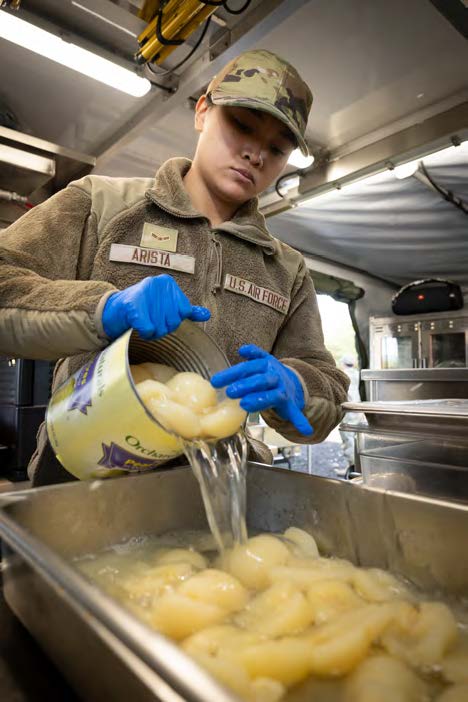
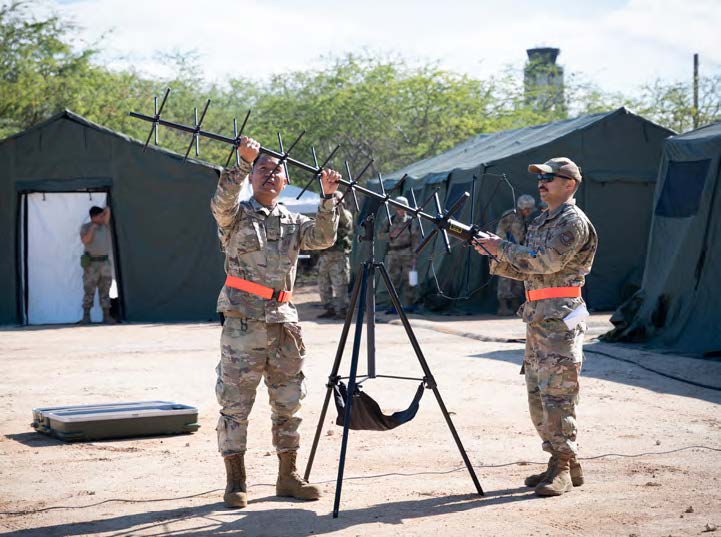
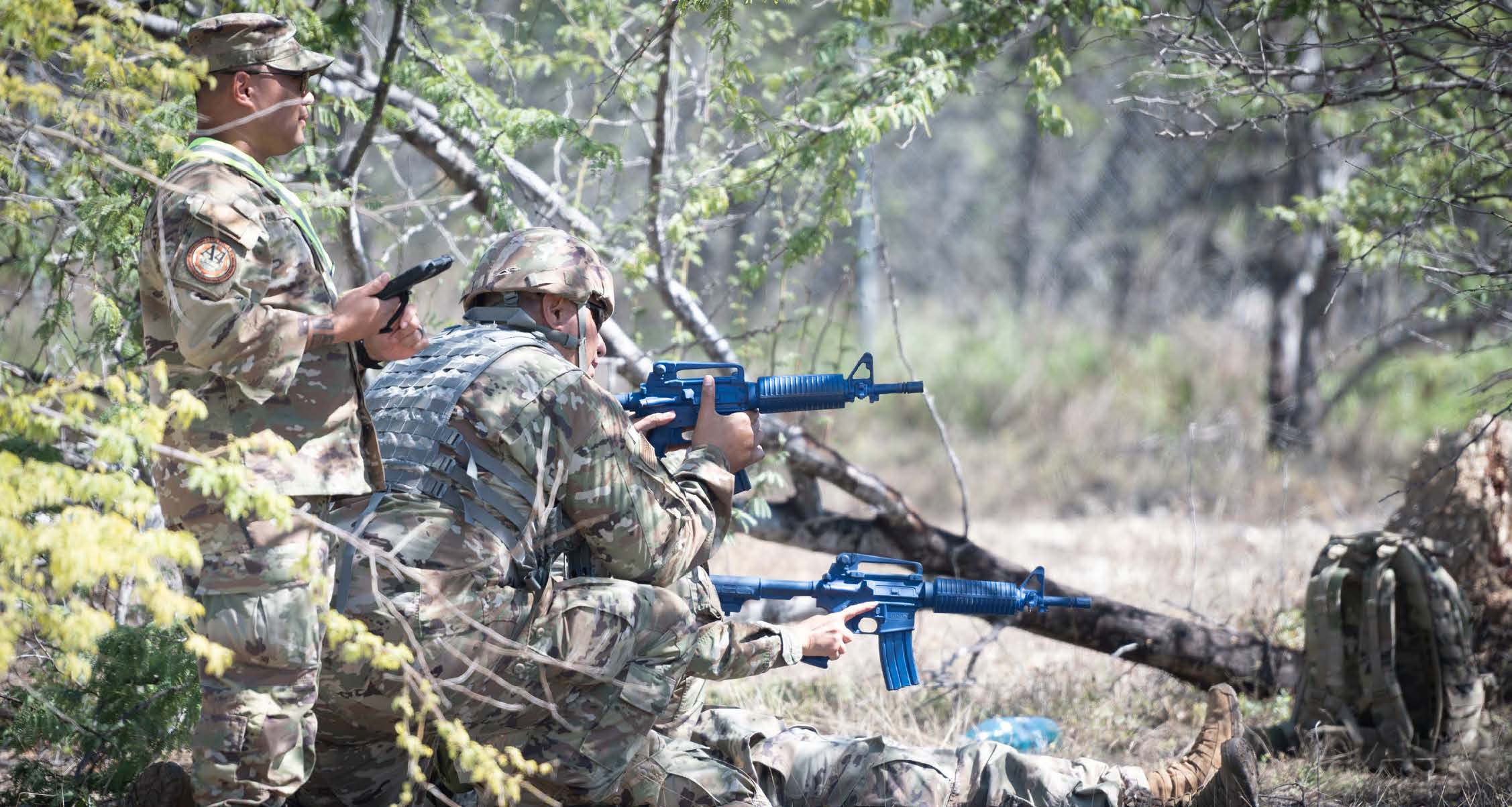 An exercise cadre monitors Airmen protecting an injured member during field training at Joint Base Pearl Harbor-Hickam, Hawaii, on Feb. 2, 2025. The exercise not only tested the Airmen’s tactical abilities but also emphasized the importance of mental resilience and quick decision-making under pressure. These exercises are critical for maintaining the operational excellence and readiness of the 154th Mission Support Group, ensuring that they remain prepared for any eventuality. (U.S. Air National Guard photo by Staff Sgt. Robert Cabuco)
An exercise cadre monitors Airmen protecting an injured member during field training at Joint Base Pearl Harbor-Hickam, Hawaii, on Feb. 2, 2025. The exercise not only tested the Airmen’s tactical abilities but also emphasized the importance of mental resilience and quick decision-making under pressure. These exercises are critical for maintaining the operational excellence and readiness of the 154th Mission Support Group, ensuring that they remain prepared for any eventuality. (U.S. Air National Guard photo by Staff Sgt. Robert Cabuco)

In an effort to enhance war fighting skills and readiness, the Hawai‘i Air National Guard’s 154th Mission Support Group (154 MSG) conducted a comprehensive training exercise over their February 1-2 Drill Weekend at Joint Base Pearl Harbor-Hickam Base X Training Area.
This two-day event aimed to reinforce tasks learned from Readiness Airman Training and apply Agile Combat Employment competencies, strengthening their ability to practice skills that lie beyond their designated career field.
The initial day of training encompassed critical topics such as base defense, incident reporting, accountability checks, tactical combat casualty care, communications and explosive ordnance hazards. Participants received instruction on comprehensive Airman fitness, including family readiness and psychological health, and applied it in field training the next day.
“The primary goal of this training is to develop and enhance Airmen’s warfighting skills,” said Col. Glen Hayase, commander of the 154th MSG. “Our approach is to offer Airmen from across the group an opportunity to learn and practice essential survival and operational skills in an expeditionary environment. Additionally, we aimed to train for and validate several mission-essential tasks for multiple units, which we accomplished. I am proud of the Airmen who participated, undertook new roles, and stepped out of their comfort zones. I am also very grateful to the team who planned and led the event.”
At daybreak, boots stepped onto the designated training area, where the hot, humid, and flat terrain posed unique challenges. The main objective was to deploy to an undisclosed location, secure an operational base, and prepare for the arrival of fighter aircraft and USAF personnel. This included securing the perimeter first, then simulating the establishment of a functional airfield, and ensuring infrastructure was in place to support sustained operations.
Personnel were tasked with securing the base, defending it from opposition forces, and setting up operations for follow-on forces. The exercise included simulated threats, such as ground assaults and air attacks, to test the participants’ readiness and response capabilities.
The service members incorporated a ‘Hub and Spoke’ deployment construct, allowing Airmen to practice securing and operating from a central location while supporting dispersed operational sites.
Participants were challenged to quickly don protective equipment as they navigated simulated chemical, biological, radiological, and nuclear threats, reinforcing their ability to operate in contaminated environments. The training emphasized the importance of communication, teamwork and preparedness for rapid forward deployment to bare bases. By adhering to the provisions outlined in the operational order, the Group enhanced its capability to deploy swiftly and decisively in support of national objectives.
Chief Master Sgt. Sean Johnson, senior enlisted leader of the 154th MSG, highlighted the importance of adapting to evolving mission requirements. He noted that the training reinforced critical readiness skills and prepared Airmen for future exercises, where they will tackle new mission-essential tasks and enhance command and control, accountability, and control center operations. The next Rodeo is expected to introduce additional challenges, further strengthening the group’s operational capabilities.
The exercise concluded with an after-action brief and feedback session, allowing participants to reflect on their performance and identify areas for improvement.
Lt. Col. Jesse Park, deputy commander of the 154th MSG, highlighted the challenges and learning opportunities posed by the training scenarios. “The scenarios are designed to be challenging to facilitate learning. Overall, the participants maintained a positive attitude and utilized teamwork to achieve exercise objectives. Moving forward, we will explore ways to enhance the curriculum and provide Airmen consistent opportunities to develop proficiency in 12 [fundamental] Ready Training Areas,” Park explained.
The exercise’s success stemmed from the strong commitment and skilled coordination of the planning and execution teams, with vital contributions from the Security Forces Squadron, Logistic Readiness Squadron, Force Support Squadron, Communication Squadron, and Civil Engineering Squadron. In one weekend, Airmen completed extensive training — securing and defending a base under simulated threats while executing critical tasks — greatly enhancing wartime readiness for rapidly establishing and sustaining airfield operations as needed.
CIVILIAN MILITARY PROGRAMS
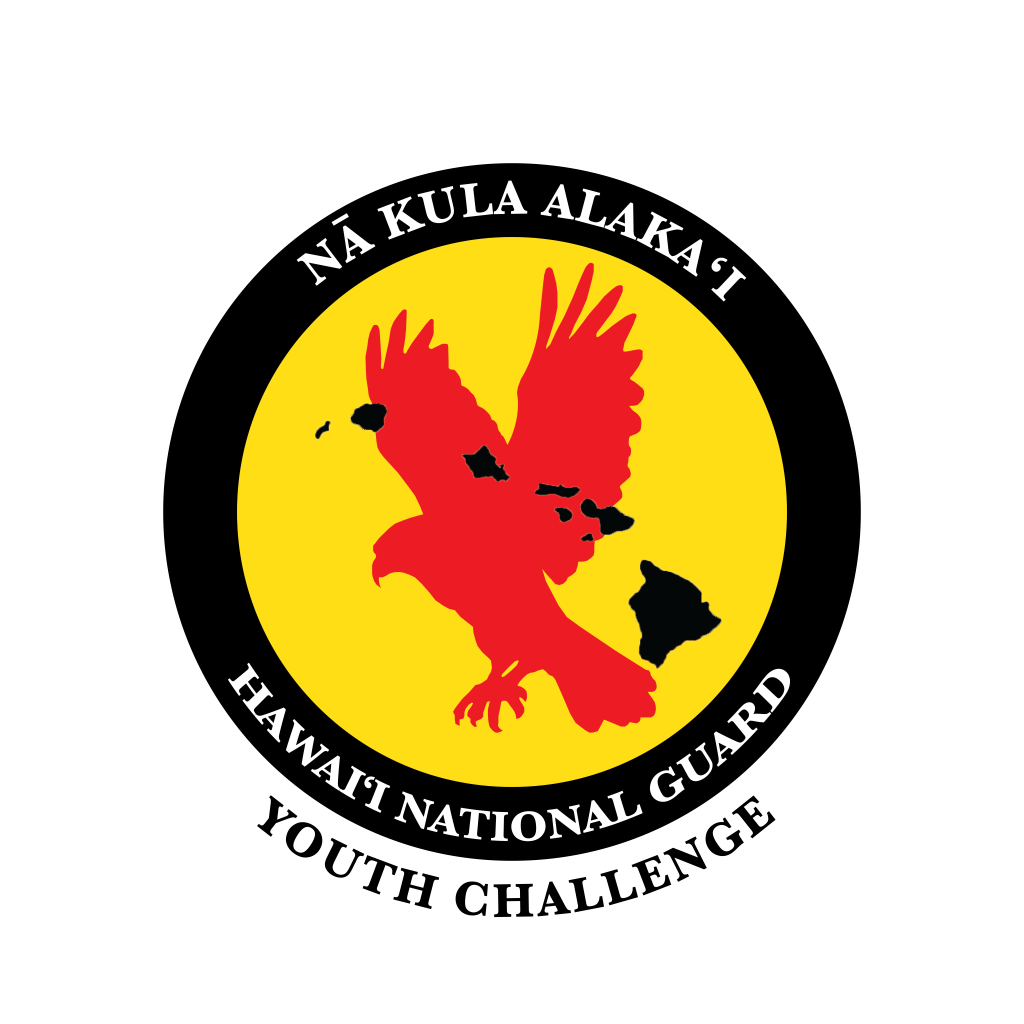
Hawai‘i Youth Challenge Academy O‘ahu Cadet Frederick Toulouse enlisting at the Military Entrance Processing Station under the new recruiting regulation that allows cadets to enlist into the Hawai‘i National Guard while still participating in the YCA Program. Cadet Toulouse of Hana, Maui, was recruited into Bravo Battery 1st Battalion, 487th Filed Artillery as a 13B Cannon Crewmember.
HAWAI‘I NATIONAL GUARD
Hawai‘i National Guard updates its emergency planning, readiness
State of Hawai‘i, Department of Defense Public Affairs Office | Story by Ruben Duldulao | Wednesday, February 5, 2025

The United States Northern Command (USNORTHCOM) Mobile Training Team (MTT) hosted a National Guard Bureau (NGB) Joint Staff Training Course (JSTC) from Feb. 1 to Feb. 5 at the State of Hawai‘i Department of Defense (HIDOD) facility on O‘ahu. A total of 33 students attended, with the majority from the Hawai‘i National Guard (HING) Joint Staff. Members from the 93rd Chemical, Biological, Radiological/Nuclear (CBRN) Enhanced Response Force Package (CERFP), 93rd Civil Support Team (CST), Nebraska National Guard and United States Indo Pacific Command also joined the five-day course.
The course was overseen by Daniel Cameron and Maj. Jeffrey Rogers, J7-22 Mobile Training Team Chief and Instructor, National Resiliency Branch. JSTC instructors are fellow Guardsmen and government civilians from around the country along with contracted support from retired, Senior Leader Army and Air Guard who reside in Colorado Springs and work at Peterson Space Force Base. This NGB program is hosted by NORAD/NORTHCOM. HING Adjutant General Maj. Gen. Stephen F. Logan and Brig. Gen. Walter R. Ross Jr., Director of Joint Staff, are both graduates of the Dual Status Commander Training Course at Peterson SFB.
“It [training] is not mandatory and it is updated on a regular basis,” Rogers said. “Things are constantly changing. Like all professions, there is turnover of key individuals and new members improve through training. The expectation is that the students, members of the Joint Staff, will immediately be prepared to respond in case of an incident or event where the National Guard is called to support.”
The students should leave the course with a greater understanding of doctrinal joint staff processes and the confidence to execute when called upon to support the citizens and communities of Hawai‘i.
“The goal is to build resilience within the staff,” Rogers said.
The course looks to enhance the planning, supporting and directing of missions specific to domestic operations unique to Hawai‘i, focusing on the initial steps of the Joint Planning Process (JPP) that includes Mission Analysis (MA) and Course of Action (COA)development. Students analyzed likely catastrophic event(s) and developed plans and courses of action to support civilian leaders in response efforts. The benefits are greater awareness of the scope and scale that National Guard elements will be asked to provide to help their communities respond and recover. The course and the others provided enhance doctrinal knowledge, improve confidence in response planning and execution and build resilience within the staffs who are chosen to develop these plans.
Hawai‘i requests MTT support on a regular basis to work directly with the HING Joint Force Headquarters. Senior leaders determine the need for the Joint Staff to receive additional training and build resiliency within the staff. The training occurs throughout the country in all 54 states, territories and Washington D.C. when requested by the respective National Guard leadership. NGB teams conduct a total of 57 courses throughout the year and seven resident courses for senior leaders.
The Hawai‘i training, last held in 2023, was increased from a Phase I two-day course to a five-day Phase I and Phase II course to help expand the HING planning process. The training utilized the JPP and the HING All-Hazard Plan 2025 in order to prepare for a Category 2 hurricane hitting O‘ahu from the south. The end of both phases culminated in presentations to Brig. Gen. Ross, who critiqued the plans and offered additional recommendations and guidance.
“This course is an academic version to rebuild the foundation, get back to the basics and build that foundation for the staff,” said Lt. Col. Isaac A Floyd, HING J7 Director of Joint Training and Exercises. “The staff is predominantly new staff or members who haven’t been in this position. About two thirds are new, one third is seasoned. It gives the seasoned individuals practice but for the new folks, exposure and understanding of the academics by the book. They see the science and then the art of how we do things and that’s why these mobile training teams are important.”
The Hawai‘i National Guard has dealt with hurricanes, lava flows and wildfires in Hawai‘i recently and that brings some first-hand experience, compared to other states.
“We’ve had almost every disaster or some type of event since 2014 starting off with the Puna lava flows,” Floyd said. “From the 2018 lava flow, the floods, the landslides, 2019 was TMT [opposition to the Thirty Meter Telescope construction on Hawai‘i Island], 2020 was COVID, then 2023 was the [Maui] wildfires and then on top of that, all the hurricanes in between. We have a lot of repetitions, a lot of experience, and the good thing is, the lower tiers are the current echelons, and then the ones that are the leaders kind of come and go – it builds up. I’ve seen it in three different echelons from being the tactical on the ground, as the incident [commander] to being [part of] the task force and then now the Joint Staff. So, I got to see all three levels based on the last ten years.”
All personnel who attended the training had to complete a Joint Domestic Operations Course (JDOC), which was Computer-Based-Training from the Joint Force Headquarters-Department of Defense Information Network Operations Center. After completing the course, they received a certificate of completion.
Sgt. Maila Julian of the 93rd CERFP attended the course for the first time and shared her experience about taking the MTT training.
“Seeing how the Joint Staff works in this class, I really learned a lot and hope that one day I get to be a part of the Joint Staff and be part of the bigger picture when it comes to planning,” Julian said.
“It’s a lot – especially coming from someone who is a lower enlisted – I don’t really get to see the bigger portion where all the staff comes together, planning things like this. I’m just a budget person, at the unit level, but when I came here, I got to see the J3 portion where it’s the operations and then the J1 where you have to process everybody that’s coming in and then there’s also the J4, the sustainment portion. So, it’s a lot to learn, but I feel like I get more out of it when you actually do the activity itself.”
HAWAI‘I ARMY NATIONAL GUARD
State Partnership Program Rotary Wing Key Leader Engagement in Hawai‘i
State of Hawai‘i, Department of Defense Public Affairs Office | Story and Photos by (Ret.) Master Sgt. Andrew Jackson | Friday, March 7, 2025
Rotary Wing aviators from the Hawai‘i Army National Guard (HIARNG) and the Armed Forces of the Philippines (AFP) held a key leader engagement on Oʻahu during the first week of March, 2025. The engagement included 103rd Troop Command Commander, Col. Phoebe Inigo, State Army Aviation Officer Lt. Col. Deanna Manriquez, Philippine Air Force 205th Tactical Helicopter Wing Commander, Brig. Gen. Alvin Hate and select members of their respective staffs. Hawai‘i and the Philippines have had a partnership through the State Partnership Program (SPP) for 25 years.
This five-day SPP key leader engagement was comprised of discussions, academic sessions and hands-on demonstrations of tactics, techniques, and procedures. It is part of a multi-year plan to increase the skill level of both the HIARNG and the AFP.
“We are here to experience first hand how the Hawai‘i National Guard conducts itʻs helicopter operations,” Hate said. “We want to learn about their operations because we are new to operating the Black Hawk (UH-60), and want to increase our capability to help the unified command of the AFP and in humanatarian assistance and disaster response operations.”
The engagement culminated with a heavy lift demonstration by the HIARNG where a UH-60 lifted a howitzer with co-ordination and communication with the 1st Battalion, 487th Field Artillery. Sling loading a Howitzer is a complex operation that requires proper rigging by Soldiers on the ground to insure the 3 ton load does not tangle or rotate in the air which destabilize the helicopter.
The SPP is a cost-effective program that is administered by the National Guard Bureau, guided by the State Department foreign policy goals and is executed by the state Adjutants Generals in support of combatant commander and U.S. Chief of Mission security cooperation objectives and Department of Defense policy goals. Through the SPP, the National Guard conducts military-to-military engagements in support of defense security goals, but also leverages whole-of-society relationships and capabilities to facilitate broader inter-agency and corollary engagements spanning military, government, economic and social spheres.
CIVILIAN MILITARY PROGRAMS
Congratulations to our STARBASE Hawai‘i Robotics Team – finishing fifth at the Hawai’i VEX IQ State Championships!
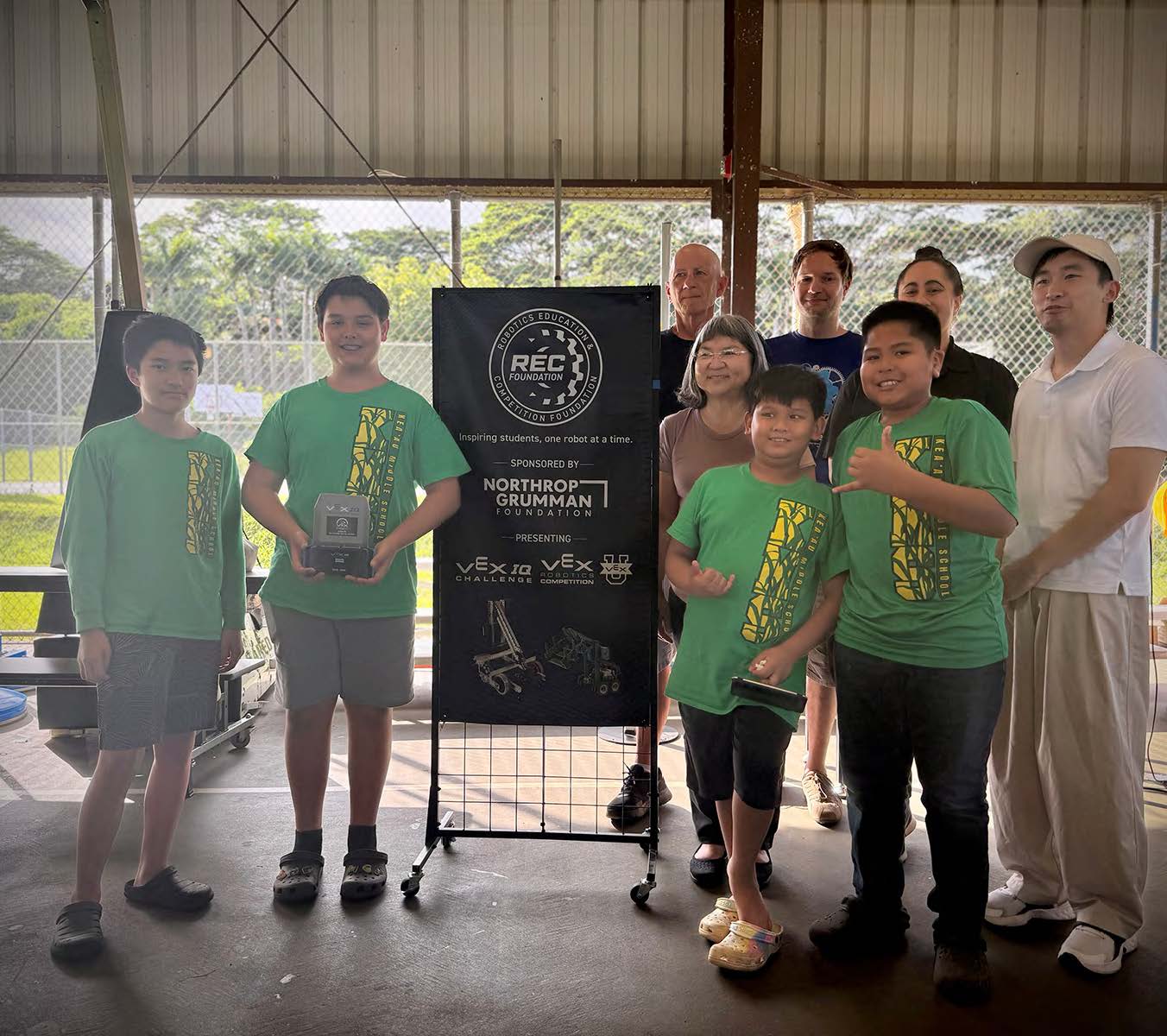
STARBASE/Kea‘au Puna Techs Team 5432B winning the Create Award at the Big Island League Finals. (Ken Smith photo)

STARBASE/Kea‘au Puna Techs Team 5432A winning the Build Award at Big Island League Finals. (Ken Smith photo)
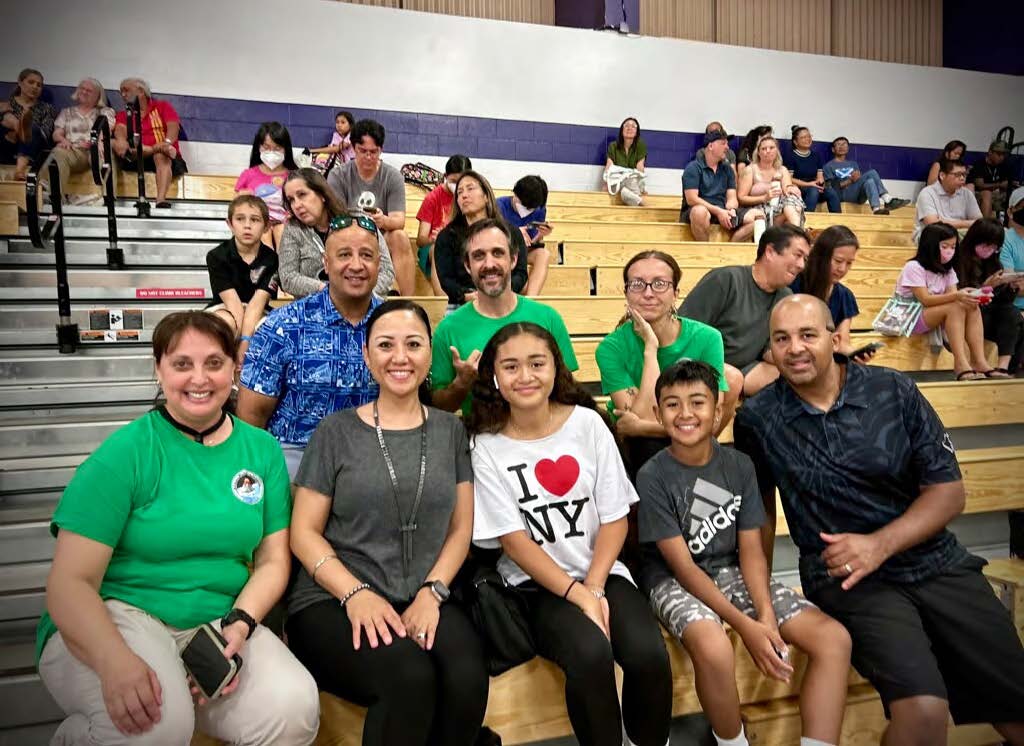
STARBASE Hawai‘i coaches (From right to left – Heather Leite, Ken Smith and Aly Clark) with Deputy Adjutant General Brig. Gen. Phillip L. Mallory and HIANG Senior Enlisted Leader Chief Master Sgt. Maryann Martin and family at the Hawai‘i VEX IQ State Championships. (Marlise Ahuna photo)
HAWAI‘I NATIONAL GUARD
Operation Homefront Holiday Meals
State of Hawai‘i, Department of Defense Public Affairs Office | Story and Photos by Rachel Blaire | Saturday, November 23, 2024
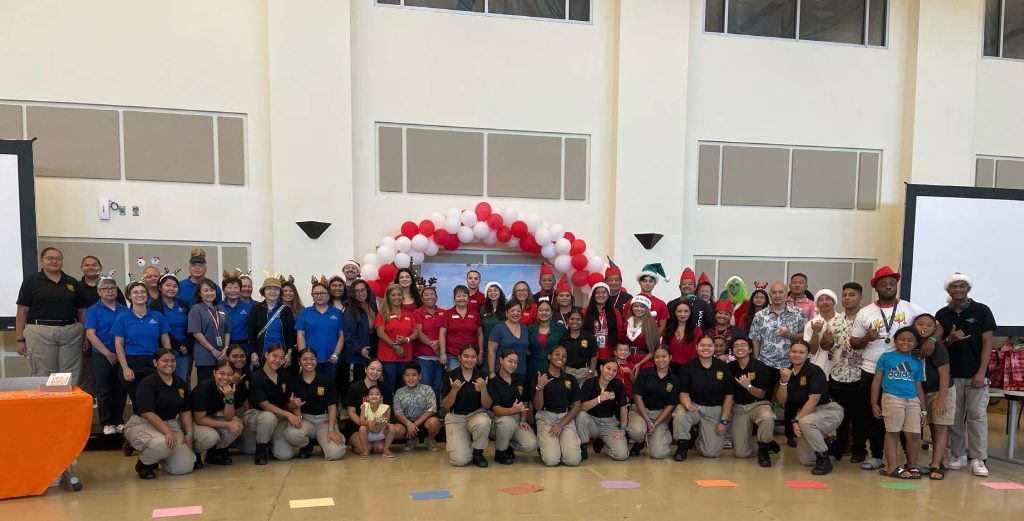
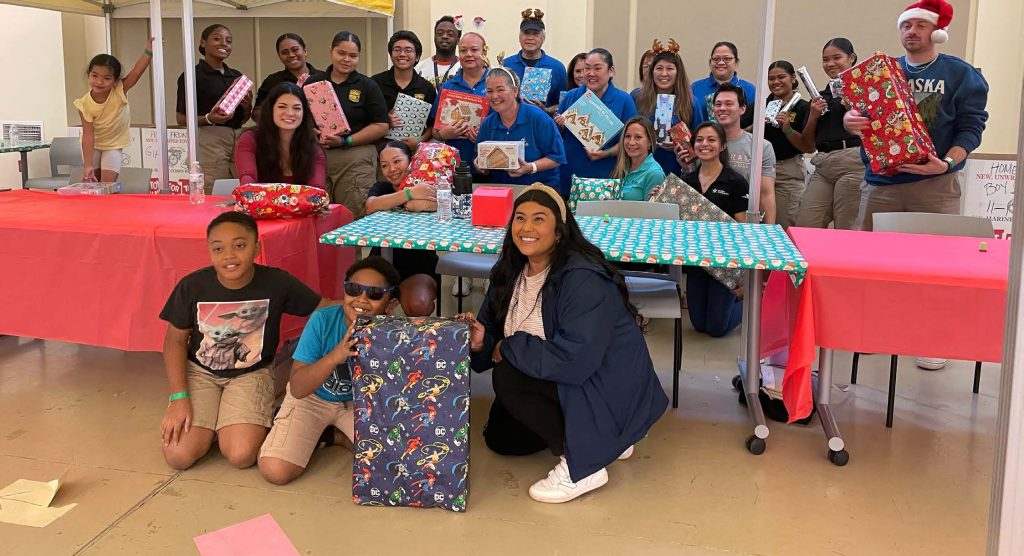

The Hawai‘i National Guard (HING) hosted Operation Homefront Holiday Meals for Military at building 29 on Nov. 23, 2024, to spread some cheer to local military families. Participating families received grocery gift cards, gifts for the keiki, many fun activities, and a photo booth.
“Operation Homefront’s mission and vision is that service members and their families should not just be living paycheck to paycheck,” said Master Sgt. Celeste Lewi who is in the Hawai‘i Army National Guard and the HING’s Yellow Ribbon Program Coordinator. “They shouldn’t just be surviving; they should be thriving in the communities they work so hard to protect…I’m just in awe that Operation Homefront really love our service members and do all they can do to take care of them.”
Building 29 was full of volunteers, families and laughter as Operation Homefront Holiday Meals commenced.
“It’s great to see families coming out and with their children, and us really giving back to them as they come through,” said Capt. Kevin Tam, 1-299th Cavalry, Plans Officer and Operation Homefront volunteer.
Families who participated in the event also received information on resources that they can use as they worked their way through the Candyland inspired room. About 350 families participated in the event.
HAWAI‘I ARMY NATIONAL GUARD
Building Strong & Ready Teams
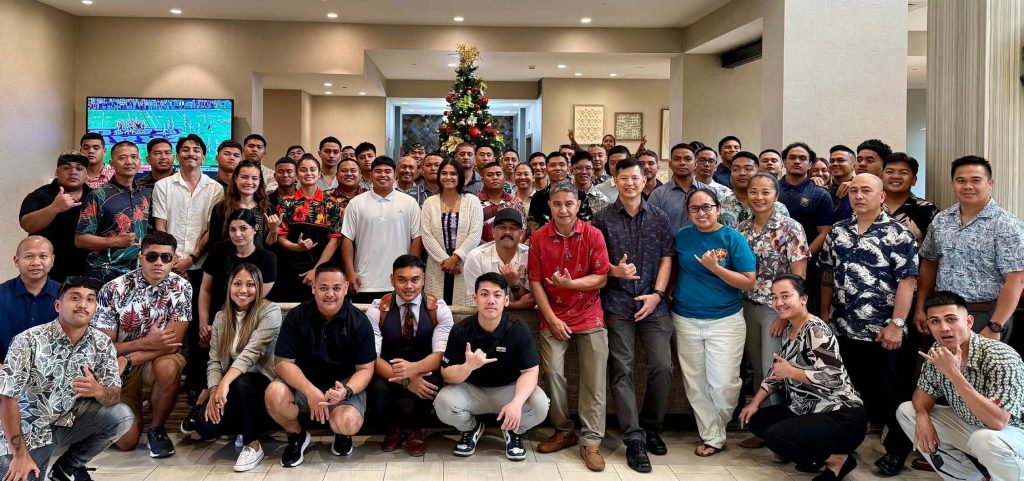

The Hawai‘i Army National Guard’s Unit Ministry Team conducted Building Strong & Ready Teams training on Dec. 7, 2024, for Company B, 29th Brigade Support Battalion. This training focused on personalities and communication, so soldiers’ relationships and life skills could enhance their readiness and resiliency when duty calls. The Building Strong & Ready Teams training was delivered through several different methods; the instructor Chaplain Major Colin Lau presented the information, which was then followed by group discussion and self-reflection. The content focused on the science of behavior (understanding people) and the art of communicating, specifically on five different communication styles. (Photo by Chaplain Maj. Colin W. Lau)
HAWAI‘I NATIONAL GUARD
2024 State Income Tax Deduction Notice

HNGEA 2024 State income Tax Deduction memo and Hawai‘i Tax Form N-11. For tax year 2024, Hawai‘i National Guardsmen are once again entitled to the benefit of income deduction from Hawai‘i State tax. For Hawai‘i Individual Income Tax Returns Tax Year 2024, increases the amount of duty pay exclusion to $8,082.00, an increase from Tax Year 2023 $7,683.00
HAWAI‘I ARMY NATIONAL GUARD
HIARNG’s Yellow Ribbon Reintegration Program extends reach during holidays
State of Hawai‘i, Department of Defense Public Affairs Office | Story by Ruben Duldulao | Saturday, December 2024
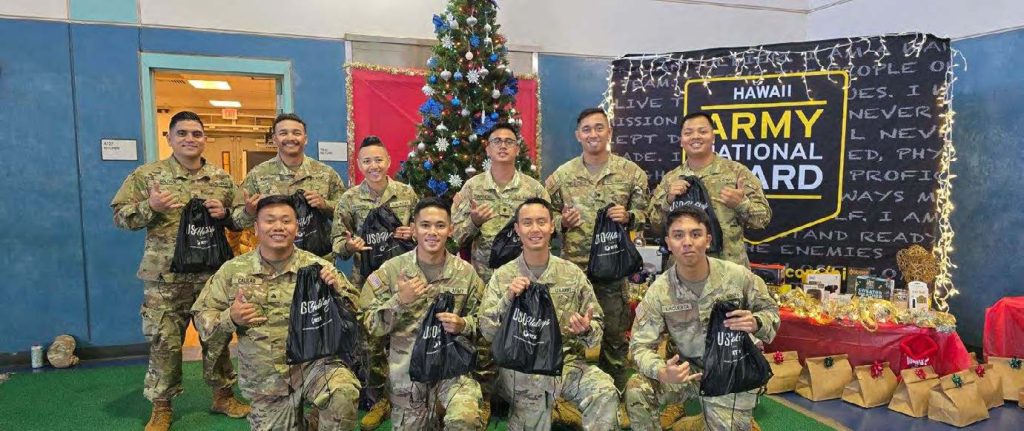


The Hawai‘i Army National Guard (HIARNG) held a Yellow Ribbon event at Kroc Center Hawai‘i in Ewa Beach on Dec. 14, 2024. Service members from the 1st Battalion, 487th Field Artillery Regiment received holiday bags from Operation Homefront and Armed Services YMCA. Gifts provided by the VA and Armed Services YMCA were wrapped and given to military children at the occasion. Yellow Ribbon events are designed to help ease the transition from being deployed and returning home.
“It’s an honor to be the HIARNG Yellow Ribbon Coordinator,” said Master Sgt. Celeste Lewi. “As a soldier who served on four combat tours and my husband who served on five overseas deployments, I really reflect on what got us through it all and what I wish we had during those times. Each deployment poses its own challenges and it’s such a journey that can’t be taken alone.”
Capt. Kevin Tam, Commander of the 1st Squadron 299th Cavalry Regiment, presented two Oahu families with gifts – one a HIARNG family and the other an active duty family where the spouse is undergoing medical challenges. Tam and First Sgt. Genesis Russell, 1-299th CAV, distributed gifts to a Hawai‘i Island family, while Sgt. 1st Class Jim Evangelista, Readiness Non-Commissioned Officer of the 230th Engineer Company, gave presents to Sgt. Hurryson Topinio, 230th ENG, and his family on Maui. Topinio’s family was directly affected by the 2023 Maui wildfires. This was the most families from the Hawai‘i National Guard that were selected in the Boot Campaign so far.
“The relationships that we have built with community partners will assist with future assistance for our service members and families,” said Lewi.
Armed Services YMCA has been instrumental in distributing food every month to Oahu military personnel at Wheeler Army Airfield, Hickam Air Force Base and Marine Corps Base Hawaii, and more recently, at the Daniel K. Akaka VA Clinic in Kapolei.
In 2024, food distributions were done four times in Hilo, three times on Maui and twice on Kaua‘i. Two food distributions on each island are planned and confirmed with local food banks this year. The distributions will rotate through the islands each quarter. This is one of the ways we can assist with food insecurity for our service members and their families.
With no Armed Services YMCA or commissary on the neighbor islands, Capt. Tam, First Sgt. Russell, Sgt. 1st Class Evangelista and Sgt. 1st Class Daynes Sacro, 1-299th CAV, have ensured those on Hawai‘i Island, Maui and Kaua‘i receive food distributions every quarter. These leaders have gone above and beyond to care for those on the neighbor islands and at many times paying out of their own pockets.
“Food distributions first started off to assist the soldiers in Hilo because they do not have a commissary,” said Tam. “It was great to get introduced to Hawai‘i Food Basket staff, who is the agency that supplies the food. They are always willing to work with the military to hold these quarterly food distributions. It is great to see so many retirees and service members come through the lines. Many have stated having the food distribution has helped them and their families greatly as food is very expensive. Hawai‘i Food Basket reported that 40% are food insecure on Hawai‘i Island and 90% of food is imported to Hawai‘i creating a crisis situation on the island.”
In December, the Yellow Ribbon Program bridged the gap between USO Hawai‘i and Maui troops, distributing 105 bags of goodies to Soldiers, and toys were received from the Marine Corp Toys for Tots Program for military children in Hilo.
“The ability to connect with national non-profits and other branches in the effort to support our service members has been so rewarding,” said Lewi. “I get excited to see resources are getting to our service members and their families. I focus on service members and their families who are in the deployment cycle. I feel like we all are training to deploy and wherever I can assist to bridge that gap and be able to prepare families, that makes deploying a little more bearable.”
The Hawai‘i Army National Guard Yellow Ribbon Reintegration Program provides valuable information, services, referral and proactive outreach opportunities for Soldiers, families, employers and youth throughout the entire deployment cycle: pre-alert, alert/pre-deployment, deployment, post-deployment and reconstitution (reintegration).
HAWAI‘I NATIONAL GUARD
Hawaiʻi National Guard Employers Fly High
State of Hawai‘i, Department of Defense Public Affairs Office | Story by Rachel Blaire | Wednesday, December 11, 2024 | Photos by Rachel Blaire
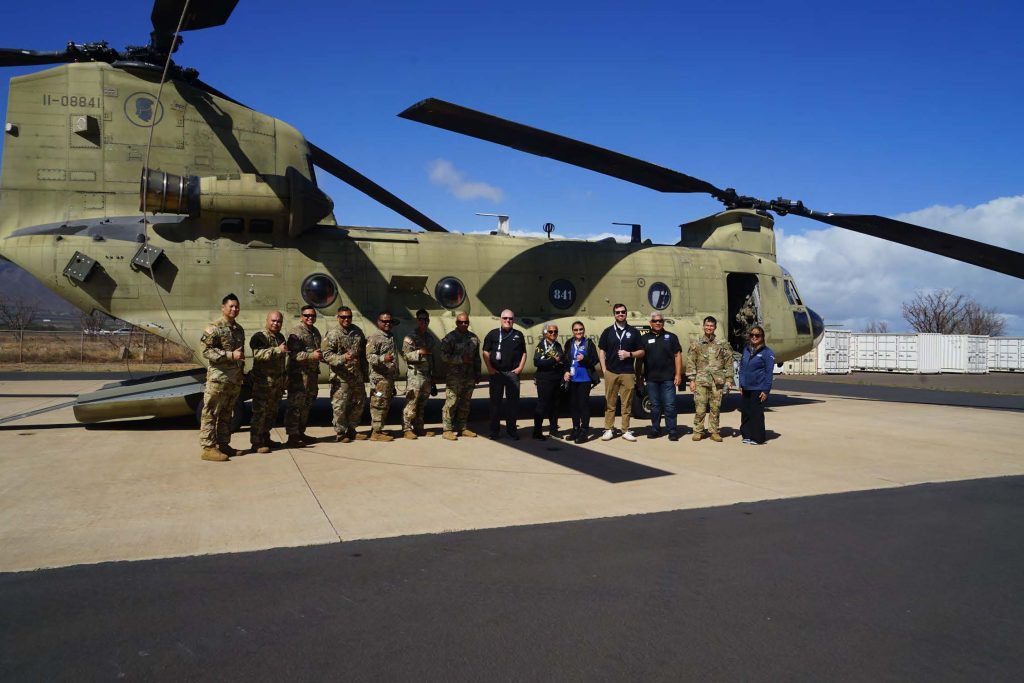
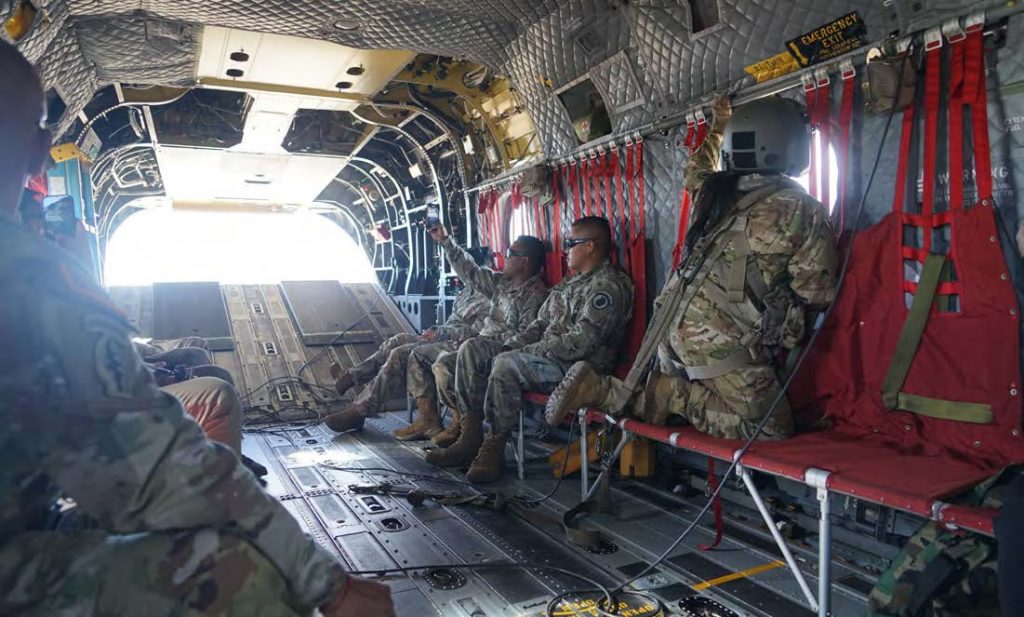
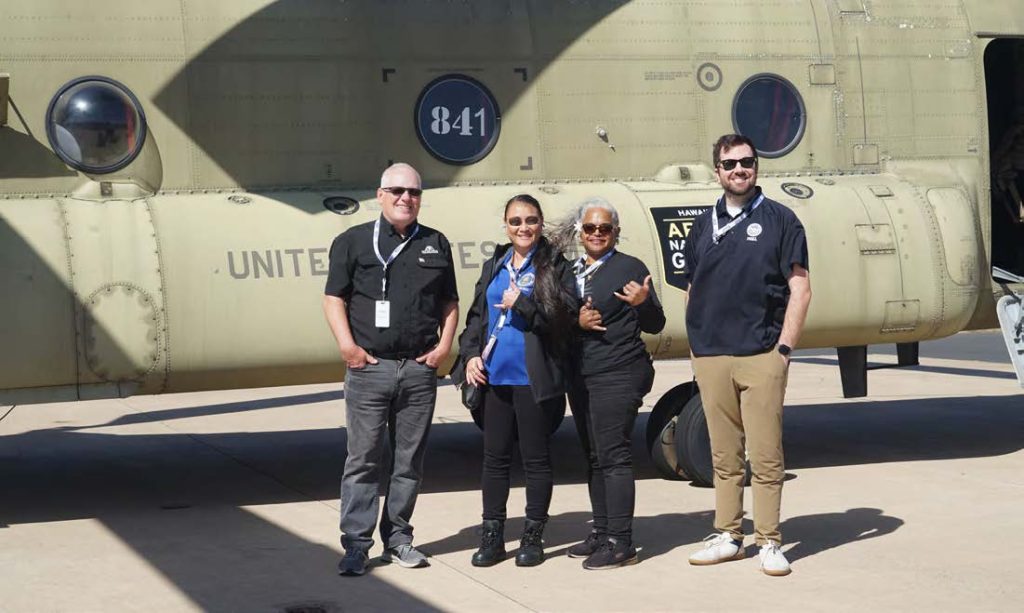

Being in the National Guard is unique as most members have a regular job on top of being a Guardsman. Guardsmen typically attend training one weekend a month and participate in two-week annual training each summer. So having a full-time job in addition to these duties means that bosses and companies need to offer some flexibility to these outstanding community members.
As a way to thank the different bosses of guard members, biannual Boss Lifts are held by the Employer Support of the Guard and Reserve. ESGR promotes cooperation and understanding between Guardsmen, Reservists and their civilian employers, and assists in resolving conflicts arising from an employee’s military commitments. These Boss Lifts allow employers to spend the day seeing what their Soldiers or Airmen do in their military position to help build the relationship.
On Dec. 11, 2024, four employers got the opportunity to see firsthand what Hawaiʻi National Guardsmen do. They started off the day by visiting the Puʻunene Armory on Maui where they met different Guardsmen and saw static displays of vehicles in the armory.
Employer Jay Ress, a general manager based out of California flew in specifically for this event. “Being able to employ to National Guard members, has been great for the company and I’m happy to be here today to show support,” said Ress.
However, the main attraction of course was a ride in a Hawaiʻi Army National Guard CH-47F Chinook Helicopter. The employers witnessed the Chinook gracefully land with winds gusting at 30 MPH and then got to meet the crew. After introductions, safety briefs and obligatory cool photos in front of the helicopter, the Chinook took off for an exciting 30-minute tour.
The pilots navigated a course over scenic Upcountry Maui and summited Haleakalā, which stands at 10,023 feet in elevation. On descent, the Chinook followed the ridgeline down to the beautiful beaches of Kihei and passed over sailboats. While the Chinook was too loud to hold a normal conversation, you could see on the employers’ faces the exhilaration of such an experience. Coming back into the armory, the employers got to participate in a dramatic exit by walking off the ramp at the back while the blades were still running.
Though the Chinook couldn’t stay as it had to return to its base, it was a positive experience for crew to show off their skill set. “The civilian employers’ unwavering support for our service in the National Guard is invaluable,” said crewman Chief Warrant Officer 3 Nyles Nakama. “The understanding, flexibility and continued employment allows us to answer the call of duty while maintaining our civilian livelihoods. We are deeply grateful for your (the Bosses) dedication to our nation and to us as we serve our Hawaiʻi community.”
Hawai‘i Emergency Management Agency
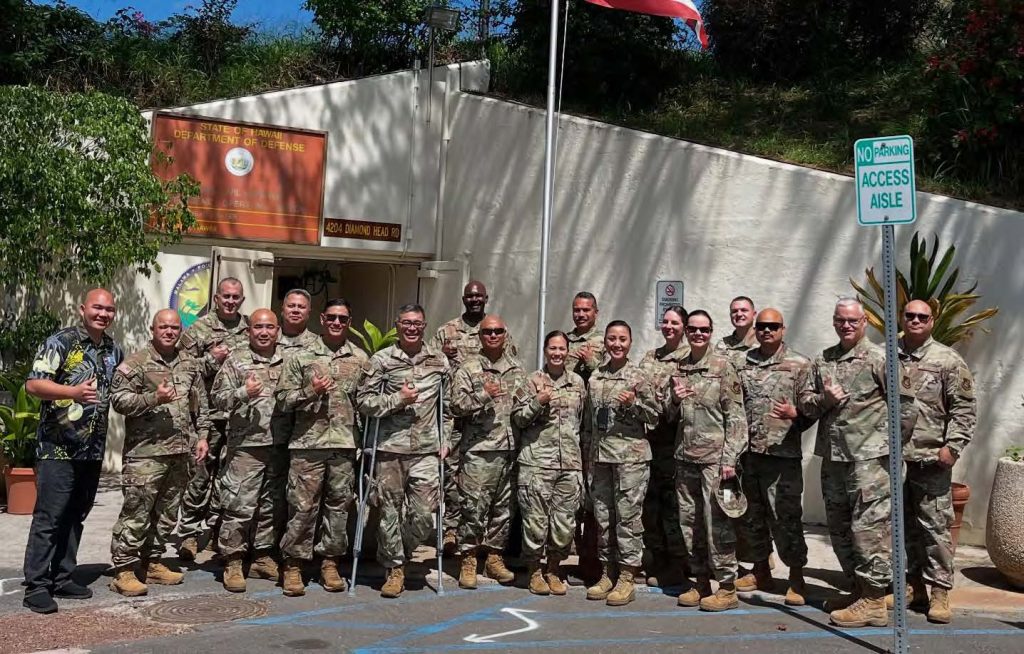
STATE OF HAWAI‘I DEPARTMENT OF DEFENSE
Federal HRO – New Hires & Transfers
Last Name, First Name, Position, Organization
- BARENG MARIO ALEX MOTOR VEHICLE OPERATOR JOINT FORCE HQ – HI
- MEYER HARMONY TOOLS AND PARTS ATTENDANT JOINT FORCE HQ – HI
- KRAUS LINDSAY HR SPEC (MILITARY) HIARNG ELEMENT – JF HQ
- OKIKAWA TYLER TOOLS AND PARTS ATTENDANT JOINT FORCE HQ – HI
- CHAN TIARE MOBILE EQUIPMENT METAL WORKER JOINT FORCE HQ – HI
- CASTRO GIL FLIGHT OPERATIONS SPECIALIST JOINT FORCE HQ – HI
- FIESTA MARK MATERIALS HANDLER JOINT FORCE HQ – HI
- TUMBAGA GIANCARLO MIGUEL SUPPLY TECHNICIAN
- NATIVIDAD QUEENIFER ACCOUNTING TECHNICIAN HIARNG ELEMENT – JF HQ
- FAGARAGAN MINA SUPPLY TECHNICIAN
- LIN XIAO LAN IT SPECIALIST (CUSTSPT/SYSADMIN)
- LEATHERMAN DANIEL PRIMARY PREVENTION SPECIALIST (PREV WF) HIARNG ELEMENT – JF HQ
- PHIPPENY TRACY EMERGENCY MANAGEMENT SPECIALIST 154 CEG SQ
- PARK TROY AIRCRAFT ENGINE MECHANIC 154 MAI SQ
- MAHOKEY JAMES COMPOSITE WORKER 154 MAI SQ
- PHIPPENY TRACY EMERGENCY MANAGEMENT SPECIALIST 154 CEG SQ
- TAKAMURA DILLON ELECTRONIC INTEGRATED SYSTEMS MECHANIC 154 MAI SQ
- OPUNUI KEVIN ORDNANCE EQUIPMENT MECHANIC 154 MAI SQ
- DRAKE CATHLEEN PHYSICAL SCIENTIST 154 CEG SQ
- LAQUIHON KENLEY AIRCRAFT ELECTRICIAN 154 MAINTENANCE SQ
- LORENZO SKYLER COMPOSITE WORKER 154 MAI SQ
- DE LA CRUZ JOHN ELECTRONIC INTEGRATED SYSTEMS MECHANIC 154 AMX SQ
- CRISTOBAL JAEDYN ELECTRONIC INTEGRATED SYSTEMS MECHANIC 154 AMX SQ
- DEL ROSARIO TYLER QUALITY ASSURANCE SPECIALIST 154 MAINTENANCE GP
- MCGHEE ADAM IT SPECIALIST (CUSTSPT) 291 COMBAT COMMUNICATIONS SQ
- SAGGERS KAINEN AIRCRAFT MECHANIC 154 AMX SQ
- CASAQUIT-GOMES JONAH MATERIALS HANDLER 154 LGR SQ
- LUNA-DELA PENA JAYNELL MATERIALS HANDLER 154 LGR SQ
- CAPINPIN JEANNELYN SECURITY SPECIALIST 154 SECURITY FORCES SQ
- LEE LANDON IT SPECIALIST (SYSADMIN) 292 CCS SQ
- TIMOTEO MICHAEL MARK IT SPECIALIST (CUSTSPT) 154 COMMUNICATIONS SQ
- CHANG GALEN IT SPECIALIST (NETWORK) 154 COMMUNICATIONS SQ
- HUNT KENNETH IT SPECIALIST (CUSTSPT) 154 CMN SQ
State HRO – New Hires & Transfers
- Afaese, Alaricson (NTE 6/30/2025) 11/1/2024 Case Manager YCA
- Braun, Kelly (Professional Trainee I) 11/1/2024 Professional Trainee I OVS
- Cazimero, Shermie (NTE 6/30/2025) 11/1/2024 Shift Leader YCA
- Daley, Patrick (NTE 6/30/2025) 11/1/2024 Information Specialist III HIEMA
- Holley, Jeraldine (NTE 6/30/2025) 11/1/2024 Lead Counselor YCA
- Malaetia, Michael 11/1/2024 Office Assistant IV HIEMA
- Roldan, Rhonda (NTE 6/30/2025) 11/1/2024 Emergency Management Specialist III – Planning HIEMA
- Yamamoto, Ryan (NTE 6/30/2025) 11/1/2024 Disaster Recovery Specialist HIEMA
- Grdjan, Karissa (NTE 6/30/2025) 11/13/24 Operations Specialist (EMPG) HIEMA
- Valdez, Yahaira (NTE 12/31/2025) 11/13/24 Human Resource Specialist (Wildfires) HIEMA
- Baldwin, Gregory (NTE 6/30/2025) 11/18/2024 Emergency Management Specialist IV HIEMA
- Murakami, Patrick 11/18/2024 Storekeeper I HIEMA
- McFall, Keith (FHR – EN26I) 12/1/2024 Engineer V ENG
- Chau, Leslie 12/2/2024 Environmental Health Specialist VI HIARNG
- Fisher, Brian (NTE 12/31/2025) 12/2/2024 Chief Recovery Officer (April 2024 Severe Storms, Flooding and Landslides) HIEMA
- Gaison, Julian (NTE 6/30/2025) 12/2/2024 EOC Warning Officer HIEMA
- Javellana, Nohelani 12/2/2024 Office Assistant IV OVS
- Soco, Manuel (NTE 6/30/2025) 12/2/2024 Grants Specialist (EMPG) HIEMA
- Stremkowski, Joseph (NTE 6/30/2025) 12/11/2024 Shift Leader YCA
- Fernandez, Joshua (NT E 6/30/2025) 12/16/2024 Cadre – Hilo YCA
- Halas, Katherine (NT 6/30/2025) 12/16/2024 Regional Catastrophic Planner (EMPG) HIEMA
- Hoe, Paul (NTE 12/31/2025) 12/16/2024 DA Program Specialist (April 2024 Severe Storms, Flooding and Landslides) HIEMA
- Kau, Francis (NTE 6/30/2025) 12/16/2024 EM Lead (RCP) (EMPG) HIEMA
- Kunimoto, Casey (NTE 12/31/2025) 12/16/2024 DA Program Specialist (April 2024 Severe Storms, Flooding and Landslides) HIEMA
- Lewis-Blades, Cyress-Angelo 12/16/2024 General Laborer I ENG
- Sponberg, Hunter (NTE 6/30/2025) 12/16/2024 EOC Warning Officer HIEMA
- Johnny Kelen (NTE 6/30/2025) 12/17/2024 Cadre – Hilo YCA
- Oshiro, Todd 12/17/2024 Information Technology, Band B (System Analyst) HIEMA
- Au Young, Waylene (NTE 6/30/2025) 1/2/2025 Civil-Military Program Director Assistant YCA
- Moon, Preston (NTE 6/30/2025) 1/2/2025 EOC Warning Officer HIEMA
- Graneld, Filippa (NTE 12/31/2025) 1/6/2025 DA Mitigation Planner – Kilauea HIEMA
- Bateman, Jacob (NTE 6/30/2025) 1/16/2025 Operations Specialist Chief (Wildfires) HIEMA
- Fernandez, Shelley (NTE 6/30/2025) 1/16/2025 Counselor YCA
- Kai, Keawapuhi (NTE 4/30/2025) 1/16/2025 Data Administrator HIARNG
- Machida, Cory (Eng III) NTE 6/30/2025 1/16/2025 Engineer III HIARNG
- Mink, Vicky 1/16/2025 Administrative Specialist IV HIARNG
- Smith, Debra (NTE 6/30/2025) 1/16/2025 EOC Warning Officer HIEMA
- Takaki, Gay (NTE 12/31/2025) 1/16/2025 Disaster Assistance Accountant HIEMA
- Ugalde, Jonette (NTE 6/30/2025) 1/16/2025 Instructor YCA
- Van Hoose, Cheryl (NTE 6/30/2025) 1/16/2025 Lead Instructor YCA
- Archuleta, Ernesto (NTE 6/30/2025) 2/3/2025 Emergency Management Specialist IV (Planning) HIEMA
- Polota, Sayan (NTE 6/30/2025) 2/3/2025 Admissions Coordinator YCA
- Rubalcava, Jack (NTE 12/31/2025) 2/3/2025 Accountant – Wildfires HIEMA
- Meade, Susan (NTE 6/30/2025) 2/10/2025 Special Projects Specialist HIEMA
- Au, Helen (NTE 6/30/2025) 2/18/2025 Logistic Management Officer (COVID19) HIEMA
- Cazimero, Shermie (NTE 6/30/2025) 2/18/2025 Secretary – Hilo YCA
- Ching, Darrick (NTE 6/30/2025) 2/18/2025 Administrative Manager HIEMA
- Borja, Zachery (NTE 6/30/2025) 2/19/2025 Log Systems Specialist – Plan Unit (COVID19) HIEMA
- Aron, Yosegne (NTE 6/30/2025) 3/3/2025 Shift Leader YCA
- Smith, Debra (NTE 6/30/2025) 3/3/2025 EOC Warning Officer HIEMA
- Burnett, Arielle 3/4/2025 Repairs & Maintenance Assistant HIARNG
- Silva, Anthony (VSC II) 3/10/2025 Veterans Services Counselor II OVS
- Maelekapowai, Casey (EHS II) 3/14/2025 Environmental Health Specialist II HIARNG
- Bailey, Weyland (ENG II) 3/17/2025 Engineer II ENG
- Amani, Taejah (NTE 6/30/2025) 3/17/2025 Shift Leader YCA
- DeGuzman-Hoomanawanui, Kaohu 3/17/2025 Janitor II ENG
- Hill, Brandon (NTE 6/30/2025) 3/17/2025 Limited English Proficiency Specialist HIEMA
- Howe, Shawn (NTE 6/30/2025) 3/17/2025 Pandemic Planner (COVID19) HIEMA
- Marzan, Anthony (NTE 6/30/2025) 3/17/2025 Assistant Direcor – YCA YCA
- Paselio, Teroa (NTE 6/30/2025) 3/17/2025 Program Coordinator YCA
- Scullion, Paul 3/17/2025 Warehouse Worker HIEMA
- Shigenaga, Bruce 3/17/2025 Purchasing Technician I HIARNG
- Yamanaka, Kelsey (NTE 6/30/2025) 3/17/2025 Special Project Lead (COVID19) HIEMA
- Yugawa, Rayson 3/17/2025 Account Clerk III ASO
- Gallahar, Mia (NTE 6/300/2025) 3/25/2025 Administrative Assistant YCA
- Amber Ramirez 11/1/24 Emergency Management Reserve Corp Specialist HIEMA
- Micah Fulgoni 11/18/24 Emergency Management Reserve Corp Specialist HIEMA
- Ronnie Arevalo III 11/18/24 Emergency Management Reserve Corp Specialist HIEMA
- John Paul Nening 12/2/24 Emergency Management Reserve Corp Specialist HIEMA
- Ian Bleakley 1/2/25 Emergency Management Reserve Corp Specialist HIEMA
- Lena Kealoha 1/2/25 Emergency Management Reserve Corp Specialist HIEMA
- Derek Kazunaga 1/6/25 General Laborer I HIANG
- Erika Liang 1/6/25 Emergency Management Reserve Corp Specialist HIEMA
- Leshaya Littlecreek-Schmidt 1/13/25 Placement Mentor Coordinator YCA
- Wayne Furuya 1/16/25 Emergency Management Reserve Corp Specialist HIEMA
- Ryan Sousa 2/11/25 Cadre – Hilo YCA
- Brett Wright 2/18/25 Cadre – Kalaeloa YCA
- CJ Andrew 2/19/25 Cadre – Hilo YCA
- Kaipo Hanawahine-Holi 3/3/25 Veterans Services Counselor III OVS
- Brooklyn-Lee Aku 3/10/25 Cadre – Hilo YCA
- Stephen Barnett 3/11/25 Cadre – Kalaeloa YCA
- Vaimetua Kamakele 3/14/25 Cadre YCA
- Angela Aburamen 3/17/25 Veterans Services Counselor III (Hilo) OVS
- Axton Ching 3/17/25 Cadre – Kalaeloa YCA
- Michaela Ramos-Carranza 3/17/25 Cadre – Kalaeloa YCA
- Taejah Amani 3/17/25 Cadre – Kalaeloa YCA

